Entrepreneurship and Business Development
VerifiedAdded on 2023/06/18
|17
|5289
|284
AI Summary
This report discusses a new business concept for Organic Shea Butter Lipstick, including key components of the concept statement, assessment of industry, market, organizational and financial feasibility, value chain analysis, and business model canvas. The report also covers marketing strategy, customer segments, and cost structure.
Contribute Materials
Your contribution can guide someone’s learning journey. Share your
documents today.
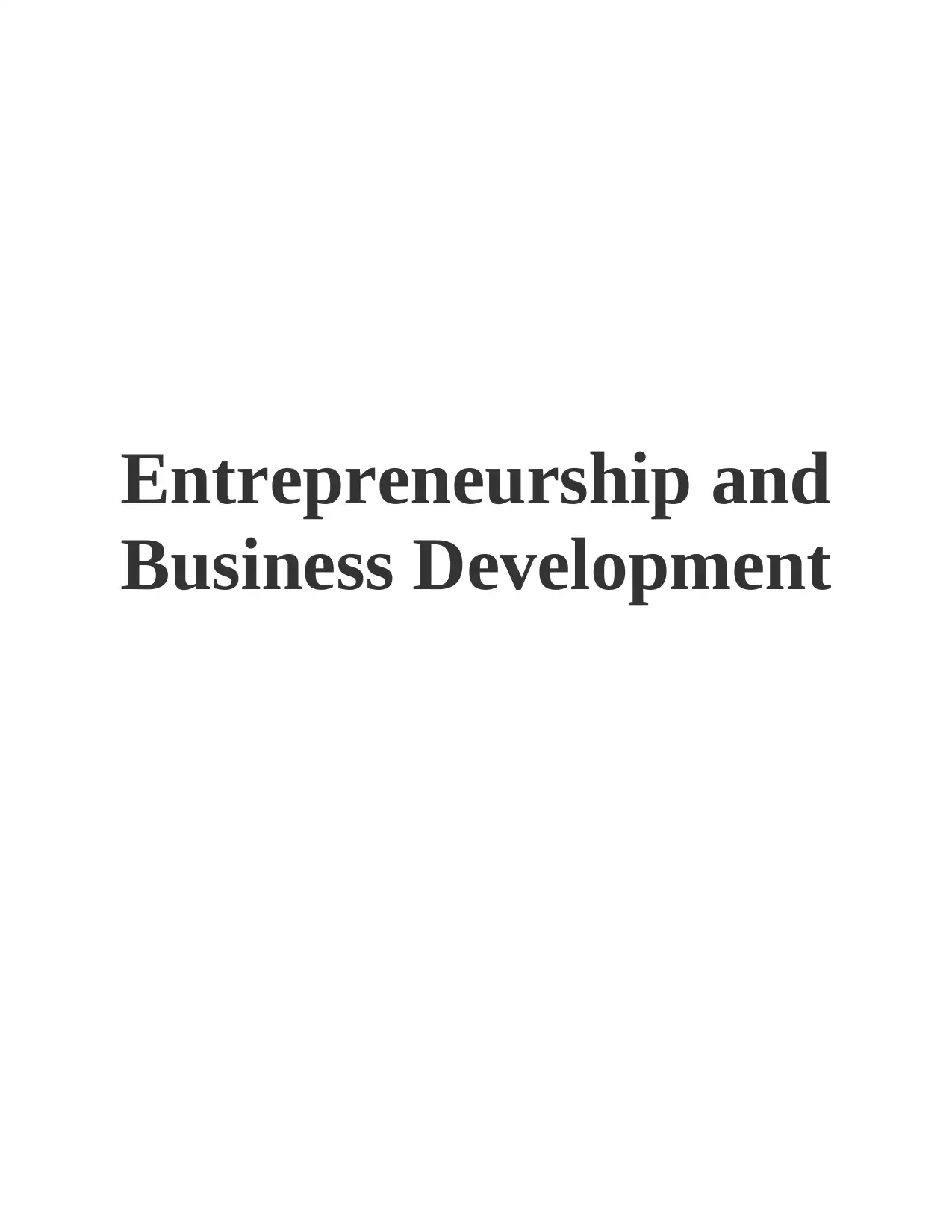
Entrepreneurship and
Business Development
Business Development
Secure Best Marks with AI Grader
Need help grading? Try our AI Grader for instant feedback on your assignments.
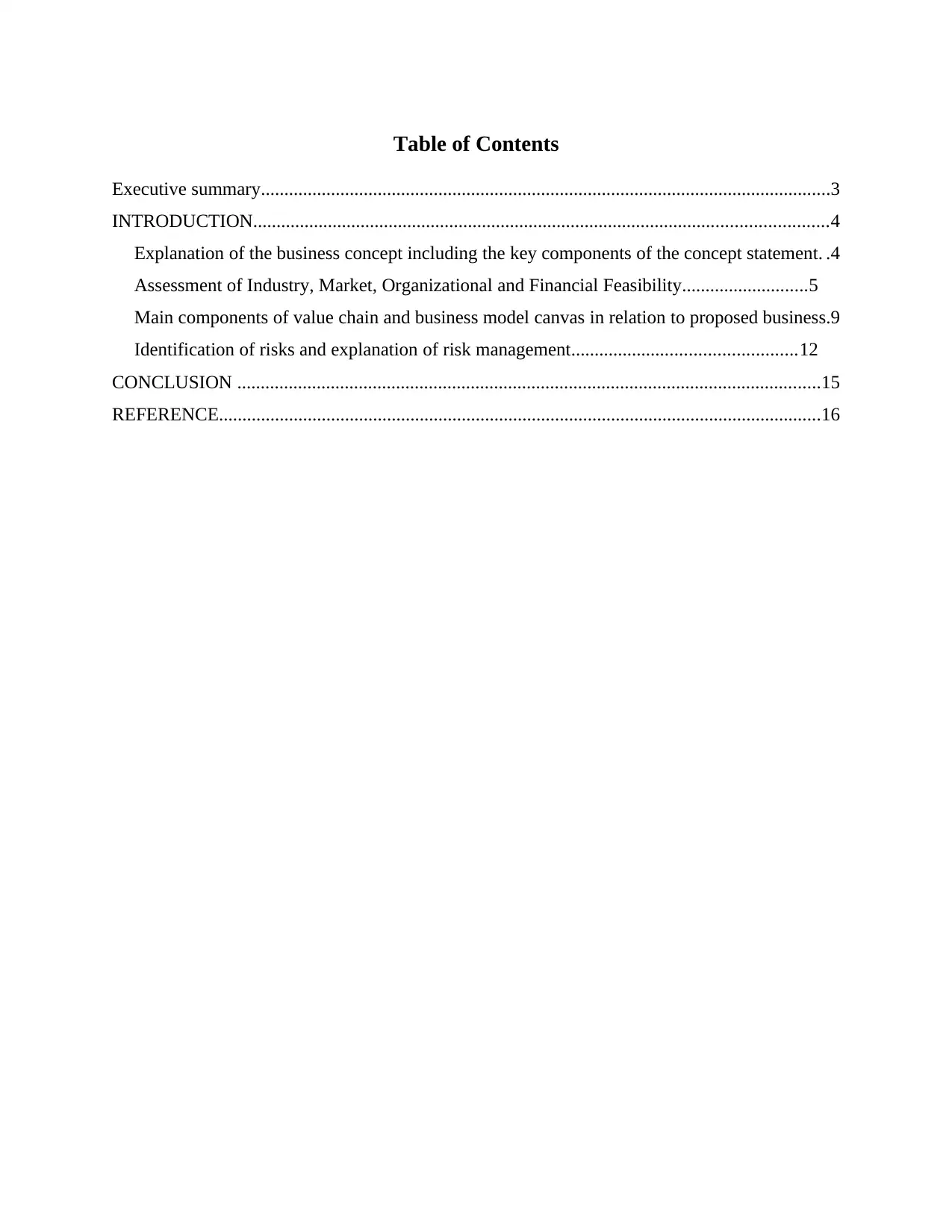
Table of Contents
Executive summary..........................................................................................................................3
INTRODUCTION...........................................................................................................................4
Explanation of the business concept including the key components of the concept statement. .4
Assessment of Industry, Market, Organizational and Financial Feasibility...........................5
Main components of value chain and business model canvas in relation to proposed business.9
Identification of risks and explanation of risk management................................................12
CONCLUSION .............................................................................................................................15
REFERENCE.................................................................................................................................16
Executive summary..........................................................................................................................3
INTRODUCTION...........................................................................................................................4
Explanation of the business concept including the key components of the concept statement. .4
Assessment of Industry, Market, Organizational and Financial Feasibility...........................5
Main components of value chain and business model canvas in relation to proposed business.9
Identification of risks and explanation of risk management................................................12
CONCLUSION .............................................................................................................................15
REFERENCE.................................................................................................................................16
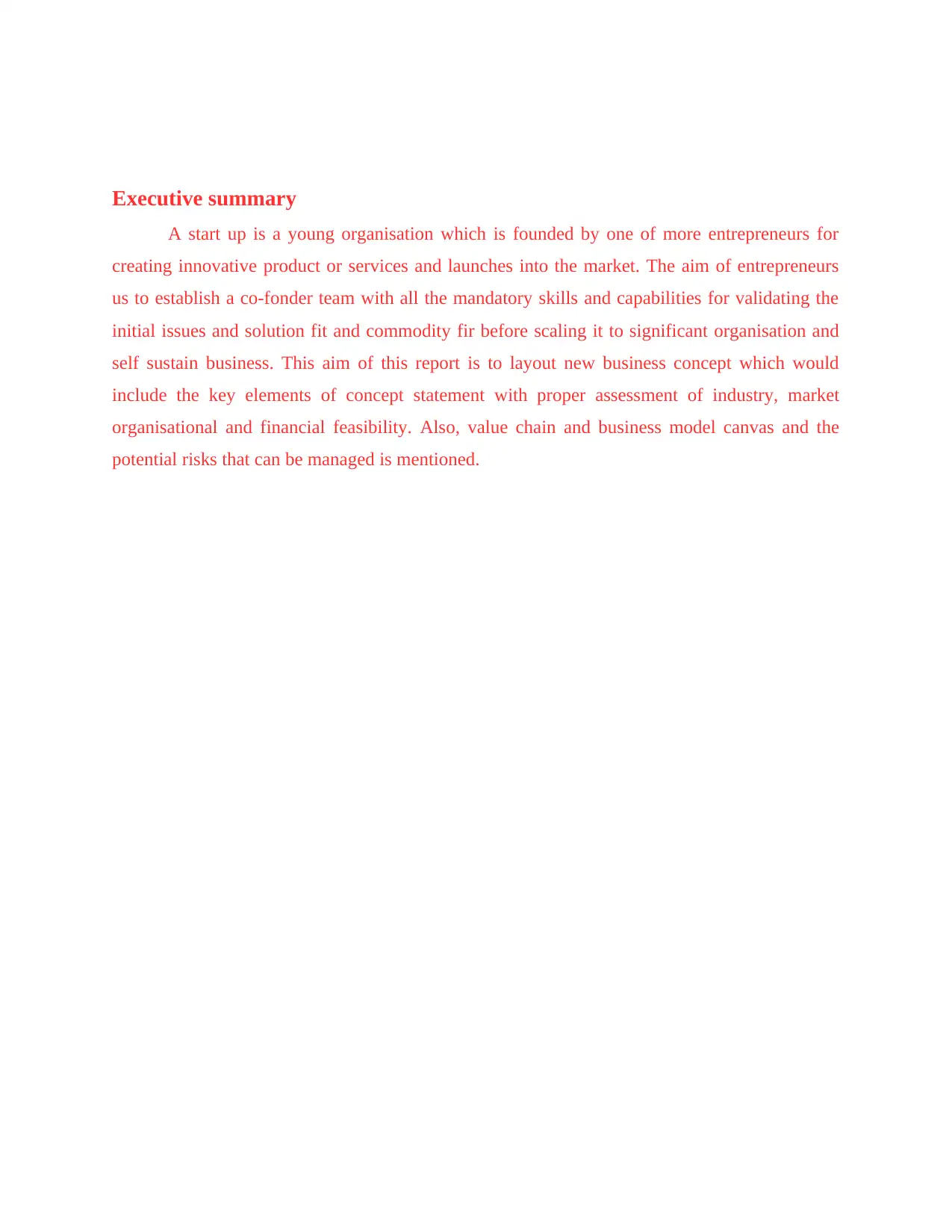
Executive summary
A start up is a young organisation which is founded by one of more entrepreneurs for
creating innovative product or services and launches into the market. The aim of entrepreneurs
us to establish a co-fonder team with all the mandatory skills and capabilities for validating the
initial issues and solution fit and commodity fir before scaling it to significant organisation and
self sustain business. This aim of this report is to layout new business concept which would
include the key elements of concept statement with proper assessment of industry, market
organisational and financial feasibility. Also, value chain and business model canvas and the
potential risks that can be managed is mentioned.
A start up is a young organisation which is founded by one of more entrepreneurs for
creating innovative product or services and launches into the market. The aim of entrepreneurs
us to establish a co-fonder team with all the mandatory skills and capabilities for validating the
initial issues and solution fit and commodity fir before scaling it to significant organisation and
self sustain business. This aim of this report is to layout new business concept which would
include the key elements of concept statement with proper assessment of industry, market
organisational and financial feasibility. Also, value chain and business model canvas and the
potential risks that can be managed is mentioned.
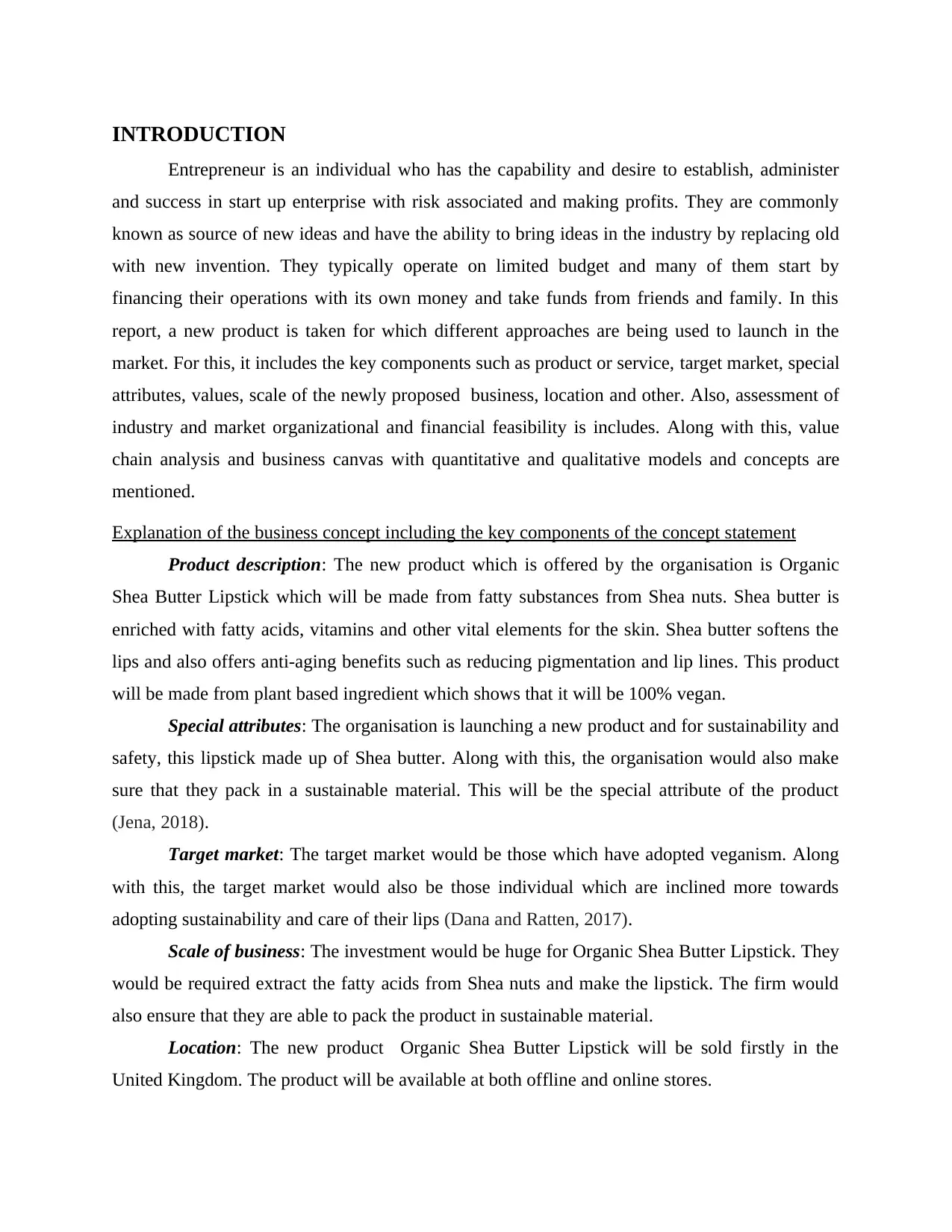
INTRODUCTION
Entrepreneur is an individual who has the capability and desire to establish, administer
and success in start up enterprise with risk associated and making profits. They are commonly
known as source of new ideas and have the ability to bring ideas in the industry by replacing old
with new invention. They typically operate on limited budget and many of them start by
financing their operations with its own money and take funds from friends and family. In this
report, a new product is taken for which different approaches are being used to launch in the
market. For this, it includes the key components such as product or service, target market, special
attributes, values, scale of the newly proposed business, location and other. Also, assessment of
industry and market organizational and financial feasibility is includes. Along with this, value
chain analysis and business canvas with quantitative and qualitative models and concepts are
mentioned.
Explanation of the business concept including the key components of the concept statement
Product description: The new product which is offered by the organisation is Organic
Shea Butter Lipstick which will be made from fatty substances from Shea nuts. Shea butter is
enriched with fatty acids, vitamins and other vital elements for the skin. Shea butter softens the
lips and also offers anti-aging benefits such as reducing pigmentation and lip lines. This product
will be made from plant based ingredient which shows that it will be 100% vegan.
Special attributes: The organisation is launching a new product and for sustainability and
safety, this lipstick made up of Shea butter. Along with this, the organisation would also make
sure that they pack in a sustainable material. This will be the special attribute of the product
(Jena, 2018).
Target market: The target market would be those which have adopted veganism. Along
with this, the target market would also be those individual which are inclined more towards
adopting sustainability and care of their lips (Dana and Ratten, 2017).
Scale of business: The investment would be huge for Organic Shea Butter Lipstick. They
would be required extract the fatty acids from Shea nuts and make the lipstick. The firm would
also ensure that they are able to pack the product in sustainable material.
Location: The new product Organic Shea Butter Lipstick will be sold firstly in the
United Kingdom. The product will be available at both offline and online stores.
Entrepreneur is an individual who has the capability and desire to establish, administer
and success in start up enterprise with risk associated and making profits. They are commonly
known as source of new ideas and have the ability to bring ideas in the industry by replacing old
with new invention. They typically operate on limited budget and many of them start by
financing their operations with its own money and take funds from friends and family. In this
report, a new product is taken for which different approaches are being used to launch in the
market. For this, it includes the key components such as product or service, target market, special
attributes, values, scale of the newly proposed business, location and other. Also, assessment of
industry and market organizational and financial feasibility is includes. Along with this, value
chain analysis and business canvas with quantitative and qualitative models and concepts are
mentioned.
Explanation of the business concept including the key components of the concept statement
Product description: The new product which is offered by the organisation is Organic
Shea Butter Lipstick which will be made from fatty substances from Shea nuts. Shea butter is
enriched with fatty acids, vitamins and other vital elements for the skin. Shea butter softens the
lips and also offers anti-aging benefits such as reducing pigmentation and lip lines. This product
will be made from plant based ingredient which shows that it will be 100% vegan.
Special attributes: The organisation is launching a new product and for sustainability and
safety, this lipstick made up of Shea butter. Along with this, the organisation would also make
sure that they pack in a sustainable material. This will be the special attribute of the product
(Jena, 2018).
Target market: The target market would be those which have adopted veganism. Along
with this, the target market would also be those individual which are inclined more towards
adopting sustainability and care of their lips (Dana and Ratten, 2017).
Scale of business: The investment would be huge for Organic Shea Butter Lipstick. They
would be required extract the fatty acids from Shea nuts and make the lipstick. The firm would
also ensure that they are able to pack the product in sustainable material.
Location: The new product Organic Shea Butter Lipstick will be sold firstly in the
United Kingdom. The product will be available at both offline and online stores.
Secure Best Marks with AI Grader
Need help grading? Try our AI Grader for instant feedback on your assignments.
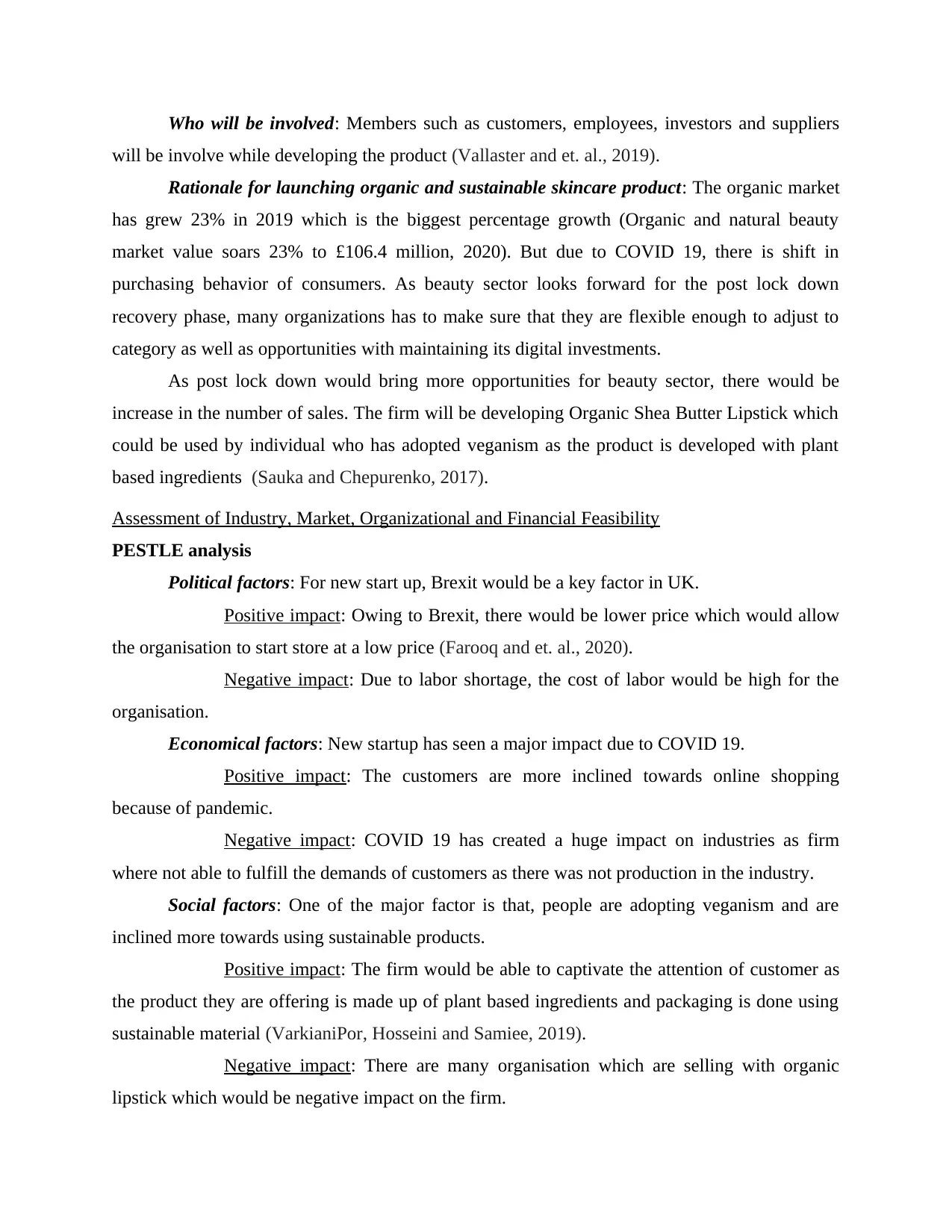
Who will be involved: Members such as customers, employees, investors and suppliers
will be involve while developing the product (Vallaster and et. al., 2019).
Rationale for launching organic and sustainable skincare product: The organic market
has grew 23% in 2019 which is the biggest percentage growth (Organic and natural beauty
market value soars 23% to £106.4 million, 2020). But due to COVID 19, there is shift in
purchasing behavior of consumers. As beauty sector looks forward for the post lock down
recovery phase, many organizations has to make sure that they are flexible enough to adjust to
category as well as opportunities with maintaining its digital investments.
As post lock down would bring more opportunities for beauty sector, there would be
increase in the number of sales. The firm will be developing Organic Shea Butter Lipstick which
could be used by individual who has adopted veganism as the product is developed with plant
based ingredients (Sauka and Chepurenko, 2017).
Assessment of Industry, Market, Organizational and Financial Feasibility
PESTLE analysis
Political factors: For new start up, Brexit would be a key factor in UK.
Positive impact: Owing to Brexit, there would be lower price which would allow
the organisation to start store at a low price (Farooq and et. al., 2020).
Negative impact: Due to labor shortage, the cost of labor would be high for the
organisation.
Economical factors: New startup has seen a major impact due to COVID 19.
Positive impact: The customers are more inclined towards online shopping
because of pandemic.
Negative impact: COVID 19 has created a huge impact on industries as firm
where not able to fulfill the demands of customers as there was not production in the industry.
Social factors: One of the major factor is that, people are adopting veganism and are
inclined more towards using sustainable products.
Positive impact: The firm would be able to captivate the attention of customer as
the product they are offering is made up of plant based ingredients and packaging is done using
sustainable material (VarkianiPor, Hosseini and Samiee, 2019).
Negative impact: There are many organisation which are selling with organic
lipstick which would be negative impact on the firm.
will be involve while developing the product (Vallaster and et. al., 2019).
Rationale for launching organic and sustainable skincare product: The organic market
has grew 23% in 2019 which is the biggest percentage growth (Organic and natural beauty
market value soars 23% to £106.4 million, 2020). But due to COVID 19, there is shift in
purchasing behavior of consumers. As beauty sector looks forward for the post lock down
recovery phase, many organizations has to make sure that they are flexible enough to adjust to
category as well as opportunities with maintaining its digital investments.
As post lock down would bring more opportunities for beauty sector, there would be
increase in the number of sales. The firm will be developing Organic Shea Butter Lipstick which
could be used by individual who has adopted veganism as the product is developed with plant
based ingredients (Sauka and Chepurenko, 2017).
Assessment of Industry, Market, Organizational and Financial Feasibility
PESTLE analysis
Political factors: For new start up, Brexit would be a key factor in UK.
Positive impact: Owing to Brexit, there would be lower price which would allow
the organisation to start store at a low price (Farooq and et. al., 2020).
Negative impact: Due to labor shortage, the cost of labor would be high for the
organisation.
Economical factors: New startup has seen a major impact due to COVID 19.
Positive impact: The customers are more inclined towards online shopping
because of pandemic.
Negative impact: COVID 19 has created a huge impact on industries as firm
where not able to fulfill the demands of customers as there was not production in the industry.
Social factors: One of the major factor is that, people are adopting veganism and are
inclined more towards using sustainable products.
Positive impact: The firm would be able to captivate the attention of customer as
the product they are offering is made up of plant based ingredients and packaging is done using
sustainable material (VarkianiPor, Hosseini and Samiee, 2019).
Negative impact: There are many organisation which are selling with organic
lipstick which would be negative impact on the firm.
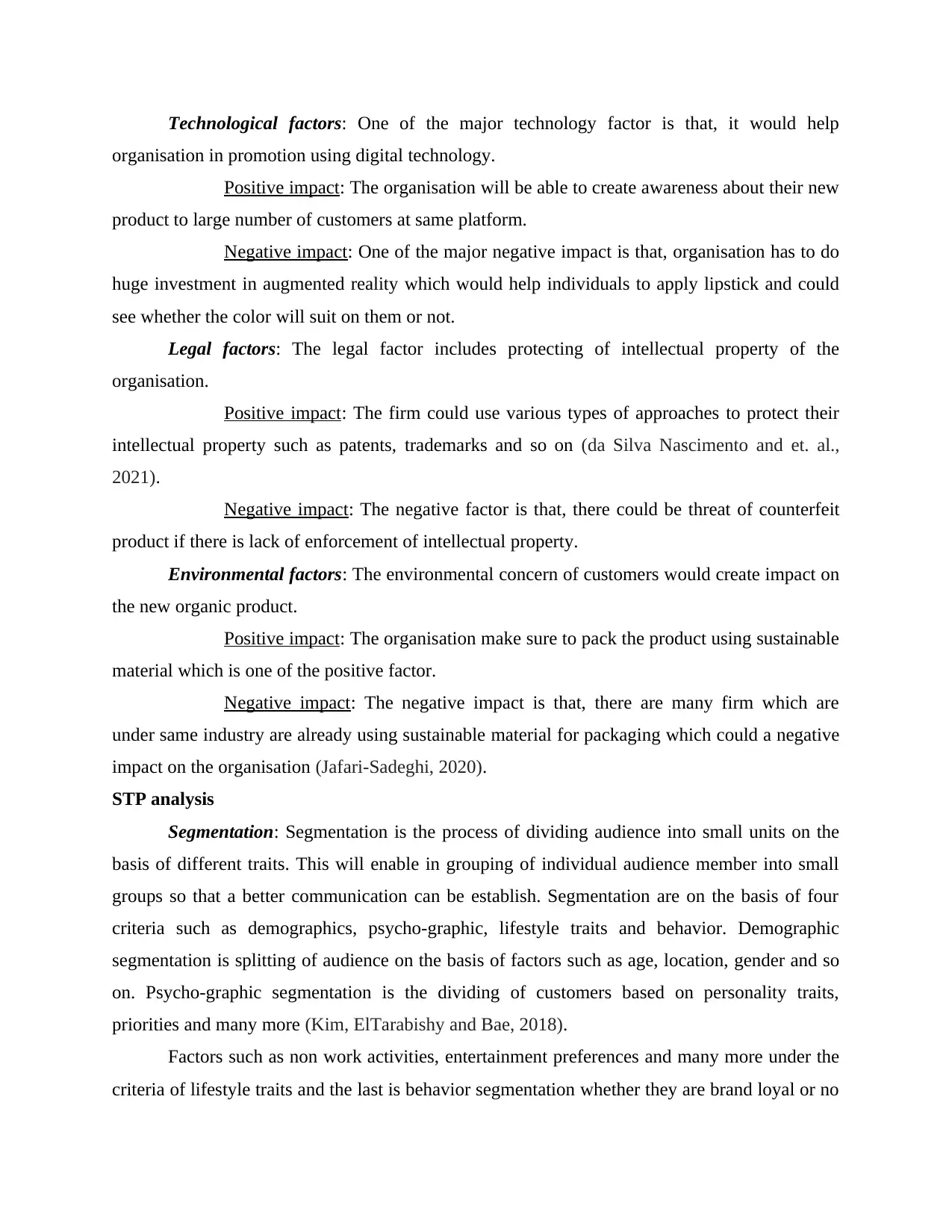
Technological factors: One of the major technology factor is that, it would help
organisation in promotion using digital technology.
Positive impact: The organisation will be able to create awareness about their new
product to large number of customers at same platform.
Negative impact: One of the major negative impact is that, organisation has to do
huge investment in augmented reality which would help individuals to apply lipstick and could
see whether the color will suit on them or not.
Legal factors: The legal factor includes protecting of intellectual property of the
organisation.
Positive impact: The firm could use various types of approaches to protect their
intellectual property such as patents, trademarks and so on (da Silva Nascimento and et. al.,
2021).
Negative impact: The negative factor is that, there could be threat of counterfeit
product if there is lack of enforcement of intellectual property.
Environmental factors: The environmental concern of customers would create impact on
the new organic product.
Positive impact: The organisation make sure to pack the product using sustainable
material which is one of the positive factor.
Negative impact: The negative impact is that, there are many firm which are
under same industry are already using sustainable material for packaging which could a negative
impact on the organisation (Jafari-Sadeghi, 2020).
STP analysis
Segmentation: Segmentation is the process of dividing audience into small units on the
basis of different traits. This will enable in grouping of individual audience member into small
groups so that a better communication can be establish. Segmentation are on the basis of four
criteria such as demographics, psycho-graphic, lifestyle traits and behavior. Demographic
segmentation is splitting of audience on the basis of factors such as age, location, gender and so
on. Psycho-graphic segmentation is the dividing of customers based on personality traits,
priorities and many more (Kim, ElTarabishy and Bae, 2018).
Factors such as non work activities, entertainment preferences and many more under the
criteria of lifestyle traits and the last is behavior segmentation whether they are brand loyal or no
organisation in promotion using digital technology.
Positive impact: The organisation will be able to create awareness about their new
product to large number of customers at same platform.
Negative impact: One of the major negative impact is that, organisation has to do
huge investment in augmented reality which would help individuals to apply lipstick and could
see whether the color will suit on them or not.
Legal factors: The legal factor includes protecting of intellectual property of the
organisation.
Positive impact: The firm could use various types of approaches to protect their
intellectual property such as patents, trademarks and so on (da Silva Nascimento and et. al.,
2021).
Negative impact: The negative factor is that, there could be threat of counterfeit
product if there is lack of enforcement of intellectual property.
Environmental factors: The environmental concern of customers would create impact on
the new organic product.
Positive impact: The organisation make sure to pack the product using sustainable
material which is one of the positive factor.
Negative impact: The negative impact is that, there are many firm which are
under same industry are already using sustainable material for packaging which could a negative
impact on the organisation (Jafari-Sadeghi, 2020).
STP analysis
Segmentation: Segmentation is the process of dividing audience into small units on the
basis of different traits. This will enable in grouping of individual audience member into small
groups so that a better communication can be establish. Segmentation are on the basis of four
criteria such as demographics, psycho-graphic, lifestyle traits and behavior. Demographic
segmentation is splitting of audience on the basis of factors such as age, location, gender and so
on. Psycho-graphic segmentation is the dividing of customers based on personality traits,
priorities and many more (Kim, ElTarabishy and Bae, 2018).
Factors such as non work activities, entertainment preferences and many more under the
criteria of lifestyle traits and the last is behavior segmentation whether they are brand loyal or no
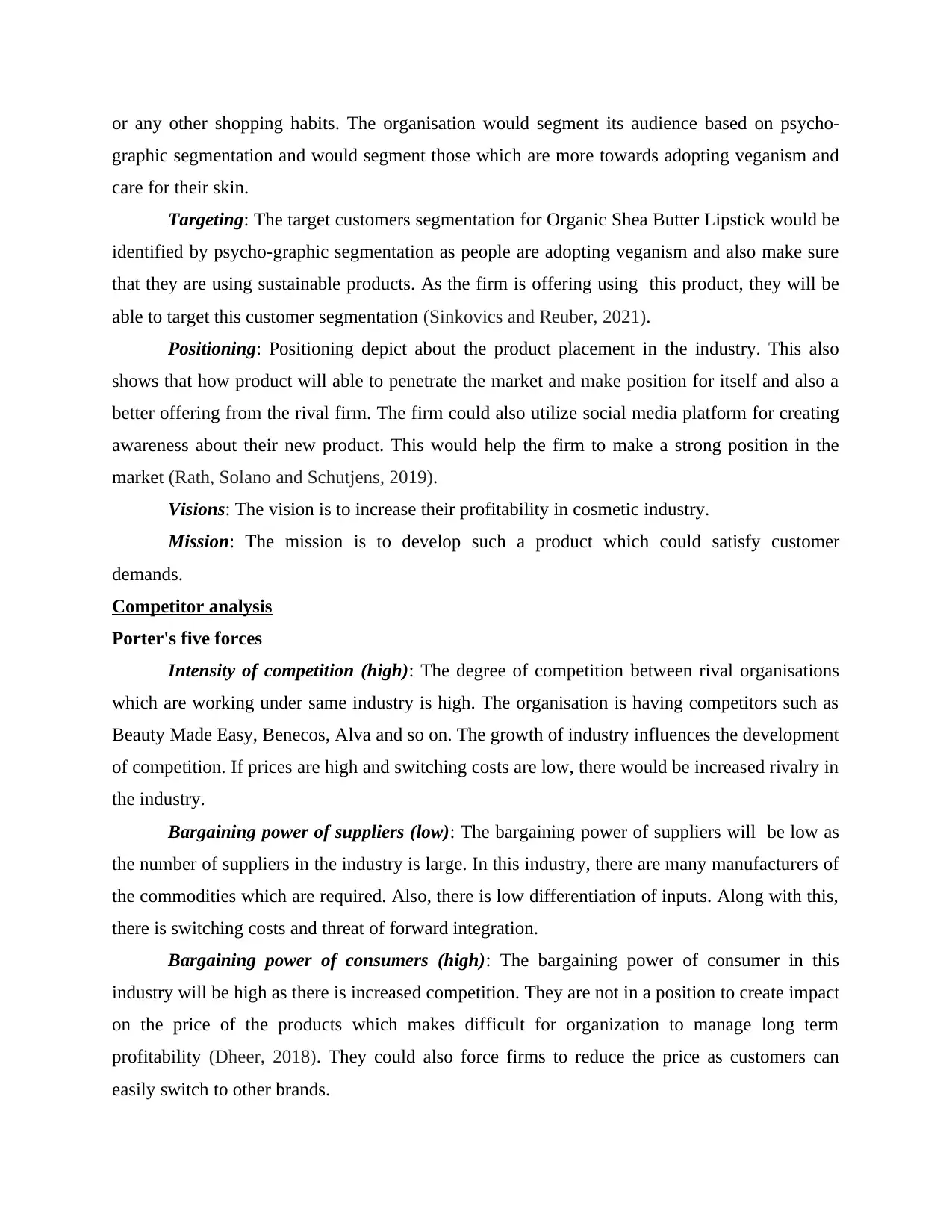
or any other shopping habits. The organisation would segment its audience based on psycho-
graphic segmentation and would segment those which are more towards adopting veganism and
care for their skin.
Targeting: The target customers segmentation for Organic Shea Butter Lipstick would be
identified by psycho-graphic segmentation as people are adopting veganism and also make sure
that they are using sustainable products. As the firm is offering using this product, they will be
able to target this customer segmentation (Sinkovics and Reuber, 2021).
Positioning: Positioning depict about the product placement in the industry. This also
shows that how product will able to penetrate the market and make position for itself and also a
better offering from the rival firm. The firm could also utilize social media platform for creating
awareness about their new product. This would help the firm to make a strong position in the
market (Rath, Solano and Schutjens, 2019).
Visions: The vision is to increase their profitability in cosmetic industry.
Mission: The mission is to develop such a product which could satisfy customer
demands.
Competitor analysis
Porter's five forces
Intensity of competition (high): The degree of competition between rival organisations
which are working under same industry is high. The organisation is having competitors such as
Beauty Made Easy, Benecos, Alva and so on. The growth of industry influences the development
of competition. If prices are high and switching costs are low, there would be increased rivalry in
the industry.
Bargaining power of suppliers (low): The bargaining power of suppliers will be low as
the number of suppliers in the industry is large. In this industry, there are many manufacturers of
the commodities which are required. Also, there is low differentiation of inputs. Along with this,
there is switching costs and threat of forward integration.
Bargaining power of consumers (high): The bargaining power of consumer in this
industry will be high as there is increased competition. They are not in a position to create impact
on the price of the products which makes difficult for organization to manage long term
profitability (Dheer, 2018). They could also force firms to reduce the price as customers can
easily switch to other brands.
graphic segmentation and would segment those which are more towards adopting veganism and
care for their skin.
Targeting: The target customers segmentation for Organic Shea Butter Lipstick would be
identified by psycho-graphic segmentation as people are adopting veganism and also make sure
that they are using sustainable products. As the firm is offering using this product, they will be
able to target this customer segmentation (Sinkovics and Reuber, 2021).
Positioning: Positioning depict about the product placement in the industry. This also
shows that how product will able to penetrate the market and make position for itself and also a
better offering from the rival firm. The firm could also utilize social media platform for creating
awareness about their new product. This would help the firm to make a strong position in the
market (Rath, Solano and Schutjens, 2019).
Visions: The vision is to increase their profitability in cosmetic industry.
Mission: The mission is to develop such a product which could satisfy customer
demands.
Competitor analysis
Porter's five forces
Intensity of competition (high): The degree of competition between rival organisations
which are working under same industry is high. The organisation is having competitors such as
Beauty Made Easy, Benecos, Alva and so on. The growth of industry influences the development
of competition. If prices are high and switching costs are low, there would be increased rivalry in
the industry.
Bargaining power of suppliers (low): The bargaining power of suppliers will be low as
the number of suppliers in the industry is large. In this industry, there are many manufacturers of
the commodities which are required. Also, there is low differentiation of inputs. Along with this,
there is switching costs and threat of forward integration.
Bargaining power of consumers (high): The bargaining power of consumer in this
industry will be high as there is increased competition. They are not in a position to create impact
on the price of the products which makes difficult for organization to manage long term
profitability (Dheer, 2018). They could also force firms to reduce the price as customers can
easily switch to other brands.
Paraphrase This Document
Need a fresh take? Get an instant paraphrase of this document with our AI Paraphraser
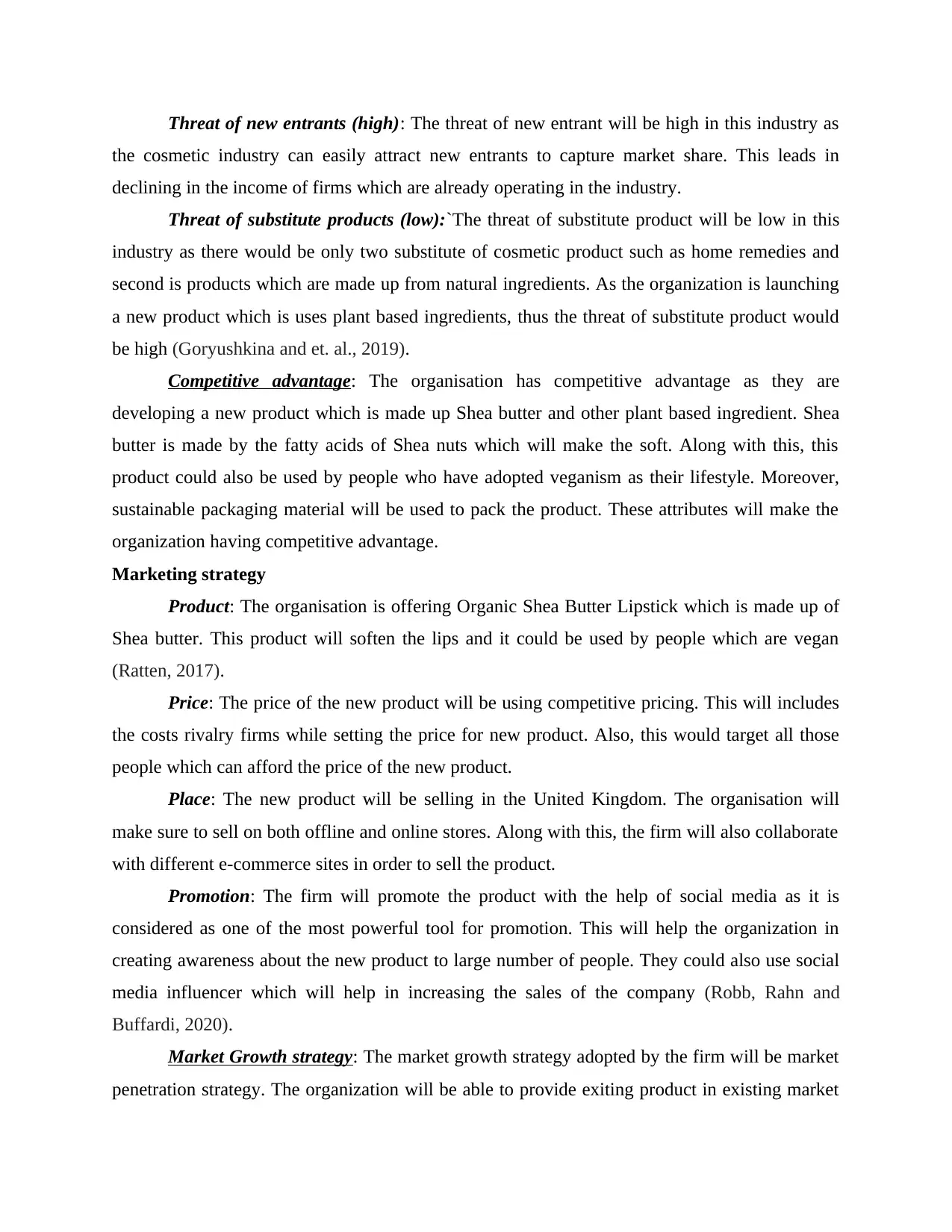
Threat of new entrants (high): The threat of new entrant will be high in this industry as
the cosmetic industry can easily attract new entrants to capture market share. This leads in
declining in the income of firms which are already operating in the industry.
Threat of substitute products (low):`The threat of substitute product will be low in this
industry as there would be only two substitute of cosmetic product such as home remedies and
second is products which are made up from natural ingredients. As the organization is launching
a new product which is uses plant based ingredients, thus the threat of substitute product would
be high (Goryushkina and et. al., 2019).
Competitive advantage: The organisation has competitive advantage as they are
developing a new product which is made up Shea butter and other plant based ingredient. Shea
butter is made by the fatty acids of Shea nuts which will make the soft. Along with this, this
product could also be used by people who have adopted veganism as their lifestyle. Moreover,
sustainable packaging material will be used to pack the product. These attributes will make the
organization having competitive advantage.
Marketing strategy
Product: The organisation is offering Organic Shea Butter Lipstick which is made up of
Shea butter. This product will soften the lips and it could be used by people which are vegan
(Ratten, 2017).
Price: The price of the new product will be using competitive pricing. This will includes
the costs rivalry firms while setting the price for new product. Also, this would target all those
people which can afford the price of the new product.
Place: The new product will be selling in the United Kingdom. The organisation will
make sure to sell on both offline and online stores. Along with this, the firm will also collaborate
with different e-commerce sites in order to sell the product.
Promotion: The firm will promote the product with the help of social media as it is
considered as one of the most powerful tool for promotion. This will help the organization in
creating awareness about the new product to large number of people. They could also use social
media influencer which will help in increasing the sales of the company (Robb, Rahn and
Buffardi, 2020).
Market Growth strategy: The market growth strategy adopted by the firm will be market
penetration strategy. The organization will be able to provide exiting product in existing market
the cosmetic industry can easily attract new entrants to capture market share. This leads in
declining in the income of firms which are already operating in the industry.
Threat of substitute products (low):`The threat of substitute product will be low in this
industry as there would be only two substitute of cosmetic product such as home remedies and
second is products which are made up from natural ingredients. As the organization is launching
a new product which is uses plant based ingredients, thus the threat of substitute product would
be high (Goryushkina and et. al., 2019).
Competitive advantage: The organisation has competitive advantage as they are
developing a new product which is made up Shea butter and other plant based ingredient. Shea
butter is made by the fatty acids of Shea nuts which will make the soft. Along with this, this
product could also be used by people who have adopted veganism as their lifestyle. Moreover,
sustainable packaging material will be used to pack the product. These attributes will make the
organization having competitive advantage.
Marketing strategy
Product: The organisation is offering Organic Shea Butter Lipstick which is made up of
Shea butter. This product will soften the lips and it could be used by people which are vegan
(Ratten, 2017).
Price: The price of the new product will be using competitive pricing. This will includes
the costs rivalry firms while setting the price for new product. Also, this would target all those
people which can afford the price of the new product.
Place: The new product will be selling in the United Kingdom. The organisation will
make sure to sell on both offline and online stores. Along with this, the firm will also collaborate
with different e-commerce sites in order to sell the product.
Promotion: The firm will promote the product with the help of social media as it is
considered as one of the most powerful tool for promotion. This will help the organization in
creating awareness about the new product to large number of people. They could also use social
media influencer which will help in increasing the sales of the company (Robb, Rahn and
Buffardi, 2020).
Market Growth strategy: The market growth strategy adopted by the firm will be market
penetration strategy. The organization will be able to provide exiting product in existing market
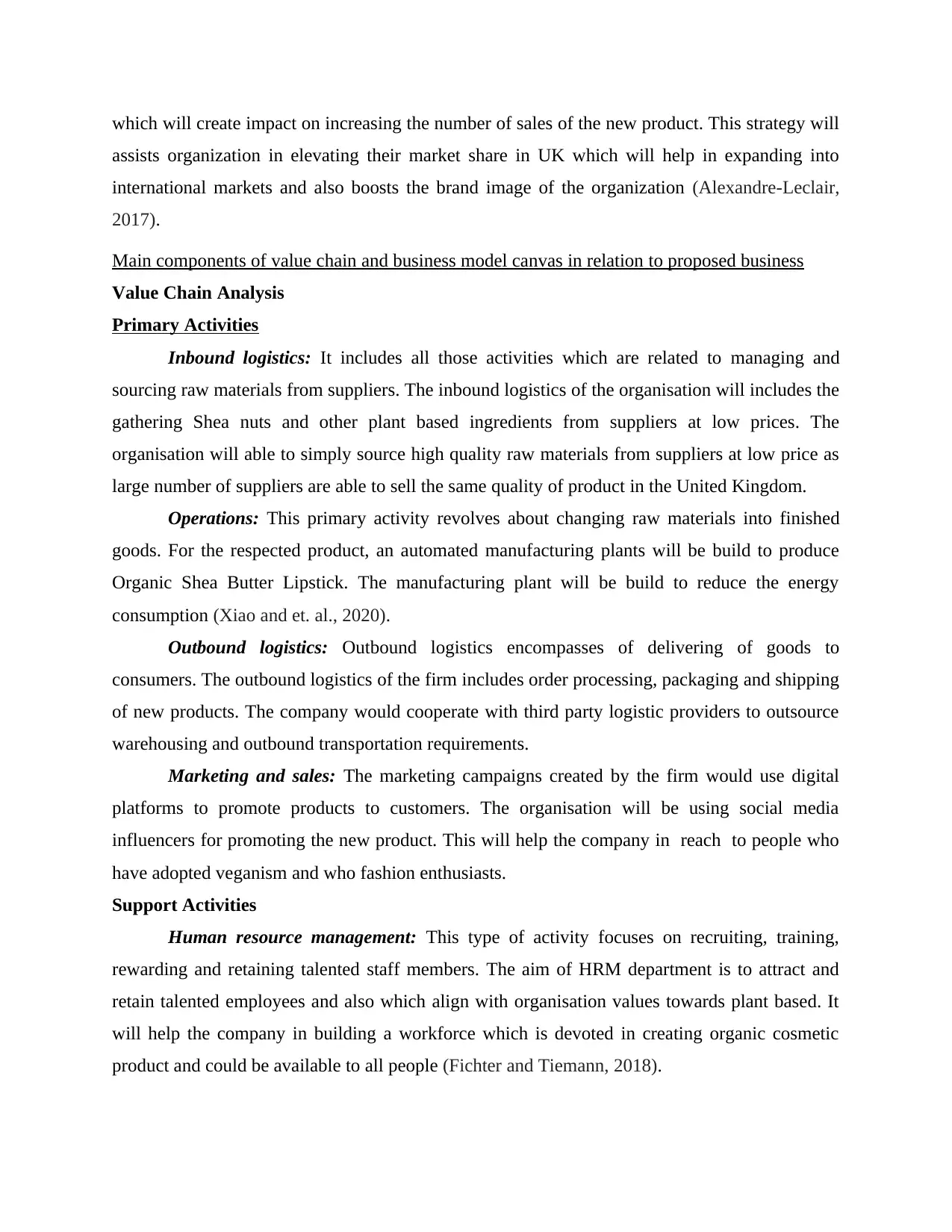
which will create impact on increasing the number of sales of the new product. This strategy will
assists organization in elevating their market share in UK which will help in expanding into
international markets and also boosts the brand image of the organization (Alexandre-Leclair,
2017).
Main components of value chain and business model canvas in relation to proposed business
Value Chain Analysis
Primary Activities
Inbound logistics: It includes all those activities which are related to managing and
sourcing raw materials from suppliers. The inbound logistics of the organisation will includes the
gathering Shea nuts and other plant based ingredients from suppliers at low prices. The
organisation will able to simply source high quality raw materials from suppliers at low price as
large number of suppliers are able to sell the same quality of product in the United Kingdom.
Operations: This primary activity revolves about changing raw materials into finished
goods. For the respected product, an automated manufacturing plants will be build to produce
Organic Shea Butter Lipstick. The manufacturing plant will be build to reduce the energy
consumption (Xiao and et. al., 2020).
Outbound logistics: Outbound logistics encompasses of delivering of goods to
consumers. The outbound logistics of the firm includes order processing, packaging and shipping
of new products. The company would cooperate with third party logistic providers to outsource
warehousing and outbound transportation requirements.
Marketing and sales: The marketing campaigns created by the firm would use digital
platforms to promote products to customers. The organisation will be using social media
influencers for promoting the new product. This will help the company in reach to people who
have adopted veganism and who fashion enthusiasts.
Support Activities
Human resource management: This type of activity focuses on recruiting, training,
rewarding and retaining talented staff members. The aim of HRM department is to attract and
retain talented employees and also which align with organisation values towards plant based. It
will help the company in building a workforce which is devoted in creating organic cosmetic
product and could be available to all people (Fichter and Tiemann, 2018).
assists organization in elevating their market share in UK which will help in expanding into
international markets and also boosts the brand image of the organization (Alexandre-Leclair,
2017).
Main components of value chain and business model canvas in relation to proposed business
Value Chain Analysis
Primary Activities
Inbound logistics: It includes all those activities which are related to managing and
sourcing raw materials from suppliers. The inbound logistics of the organisation will includes the
gathering Shea nuts and other plant based ingredients from suppliers at low prices. The
organisation will able to simply source high quality raw materials from suppliers at low price as
large number of suppliers are able to sell the same quality of product in the United Kingdom.
Operations: This primary activity revolves about changing raw materials into finished
goods. For the respected product, an automated manufacturing plants will be build to produce
Organic Shea Butter Lipstick. The manufacturing plant will be build to reduce the energy
consumption (Xiao and et. al., 2020).
Outbound logistics: Outbound logistics encompasses of delivering of goods to
consumers. The outbound logistics of the firm includes order processing, packaging and shipping
of new products. The company would cooperate with third party logistic providers to outsource
warehousing and outbound transportation requirements.
Marketing and sales: The marketing campaigns created by the firm would use digital
platforms to promote products to customers. The organisation will be using social media
influencers for promoting the new product. This will help the company in reach to people who
have adopted veganism and who fashion enthusiasts.
Support Activities
Human resource management: This type of activity focuses on recruiting, training,
rewarding and retaining talented staff members. The aim of HRM department is to attract and
retain talented employees and also which align with organisation values towards plant based. It
will help the company in building a workforce which is devoted in creating organic cosmetic
product and could be available to all people (Fichter and Tiemann, 2018).
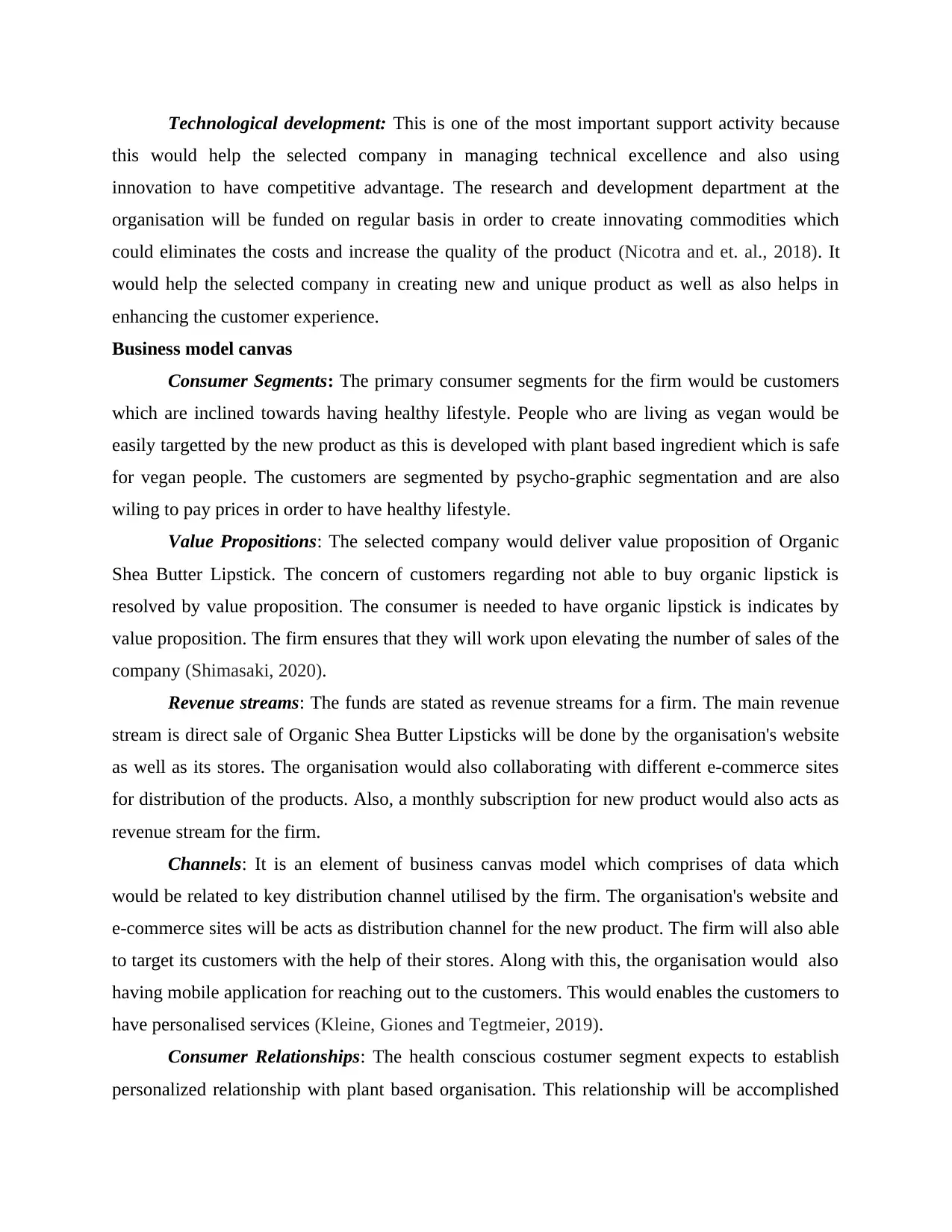
Technological development: This is one of the most important support activity because
this would help the selected company in managing technical excellence and also using
innovation to have competitive advantage. The research and development department at the
organisation will be funded on regular basis in order to create innovating commodities which
could eliminates the costs and increase the quality of the product (Nicotra and et. al., 2018). It
would help the selected company in creating new and unique product as well as also helps in
enhancing the customer experience.
Business model canvas
Consumer Segments: The primary consumer segments for the firm would be customers
which are inclined towards having healthy lifestyle. People who are living as vegan would be
easily targetted by the new product as this is developed with plant based ingredient which is safe
for vegan people. The customers are segmented by psycho-graphic segmentation and are also
wiling to pay prices in order to have healthy lifestyle.
Value Propositions: The selected company would deliver value proposition of Organic
Shea Butter Lipstick. The concern of customers regarding not able to buy organic lipstick is
resolved by value proposition. The consumer is needed to have organic lipstick is indicates by
value proposition. The firm ensures that they will work upon elevating the number of sales of the
company (Shimasaki, 2020).
Revenue streams: The funds are stated as revenue streams for a firm. The main revenue
stream is direct sale of Organic Shea Butter Lipsticks will be done by the organisation's website
as well as its stores. The organisation would also collaborating with different e-commerce sites
for distribution of the products. Also, a monthly subscription for new product would also acts as
revenue stream for the firm.
Channels: It is an element of business canvas model which comprises of data which
would be related to key distribution channel utilised by the firm. The organisation's website and
e-commerce sites will be acts as distribution channel for the new product. The firm will also able
to target its customers with the help of their stores. Along with this, the organisation would also
having mobile application for reaching out to the customers. This would enables the customers to
have personalised services (Kleine, Giones and Tegtmeier, 2019).
Consumer Relationships: The health conscious costumer segment expects to establish
personalized relationship with plant based organisation. This relationship will be accomplished
this would help the selected company in managing technical excellence and also using
innovation to have competitive advantage. The research and development department at the
organisation will be funded on regular basis in order to create innovating commodities which
could eliminates the costs and increase the quality of the product (Nicotra and et. al., 2018). It
would help the selected company in creating new and unique product as well as also helps in
enhancing the customer experience.
Business model canvas
Consumer Segments: The primary consumer segments for the firm would be customers
which are inclined towards having healthy lifestyle. People who are living as vegan would be
easily targetted by the new product as this is developed with plant based ingredient which is safe
for vegan people. The customers are segmented by psycho-graphic segmentation and are also
wiling to pay prices in order to have healthy lifestyle.
Value Propositions: The selected company would deliver value proposition of Organic
Shea Butter Lipstick. The concern of customers regarding not able to buy organic lipstick is
resolved by value proposition. The consumer is needed to have organic lipstick is indicates by
value proposition. The firm ensures that they will work upon elevating the number of sales of the
company (Shimasaki, 2020).
Revenue streams: The funds are stated as revenue streams for a firm. The main revenue
stream is direct sale of Organic Shea Butter Lipsticks will be done by the organisation's website
as well as its stores. The organisation would also collaborating with different e-commerce sites
for distribution of the products. Also, a monthly subscription for new product would also acts as
revenue stream for the firm.
Channels: It is an element of business canvas model which comprises of data which
would be related to key distribution channel utilised by the firm. The organisation's website and
e-commerce sites will be acts as distribution channel for the new product. The firm will also able
to target its customers with the help of their stores. Along with this, the organisation would also
having mobile application for reaching out to the customers. This would enables the customers to
have personalised services (Kleine, Giones and Tegtmeier, 2019).
Consumer Relationships: The health conscious costumer segment expects to establish
personalized relationship with plant based organisation. This relationship will be accomplished
Secure Best Marks with AI Grader
Need help grading? Try our AI Grader for instant feedback on your assignments.
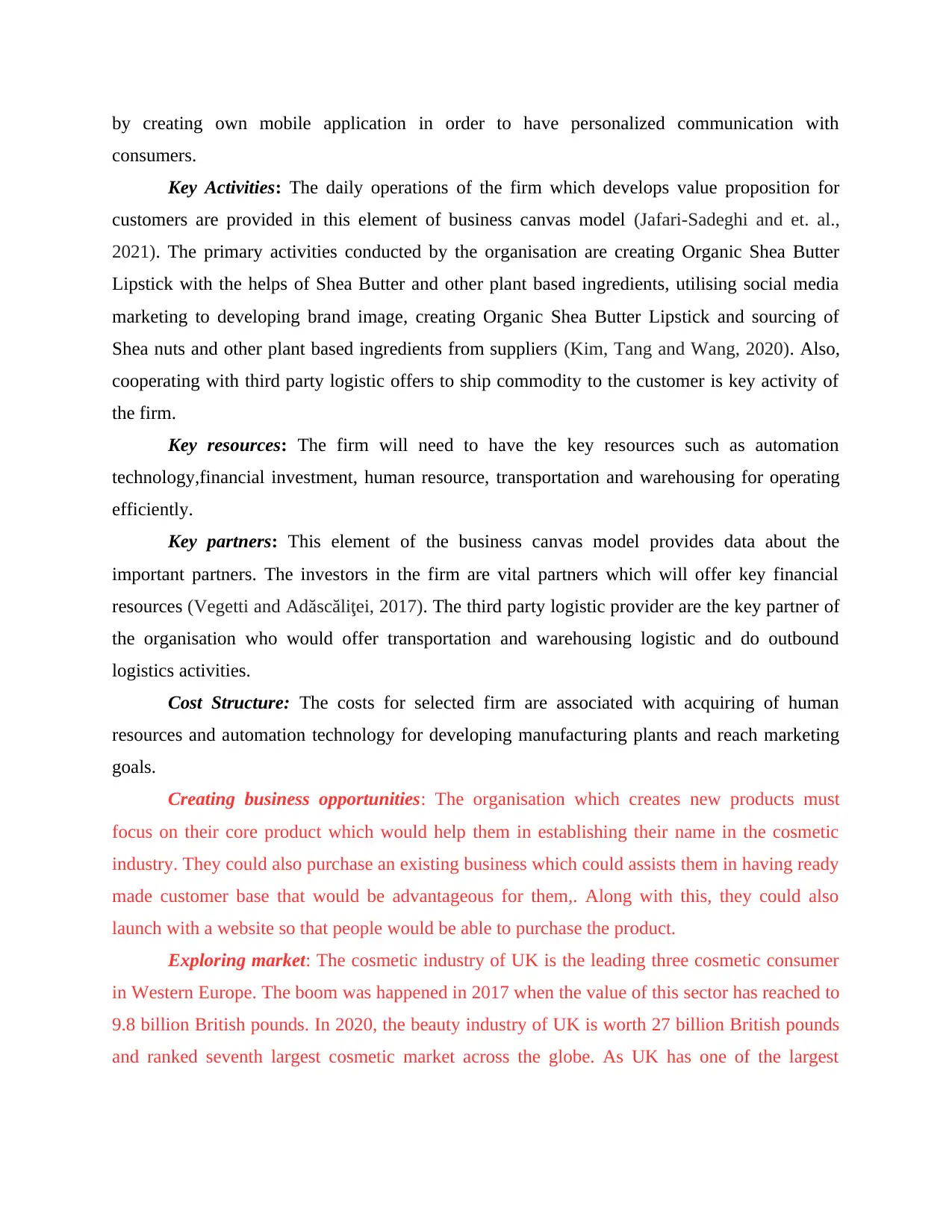
by creating own mobile application in order to have personalized communication with
consumers.
Key Activities: The daily operations of the firm which develops value proposition for
customers are provided in this element of business canvas model (Jafari-Sadeghi and et. al.,
2021). The primary activities conducted by the organisation are creating Organic Shea Butter
Lipstick with the helps of Shea Butter and other plant based ingredients, utilising social media
marketing to developing brand image, creating Organic Shea Butter Lipstick and sourcing of
Shea nuts and other plant based ingredients from suppliers (Kim, Tang and Wang, 2020). Also,
cooperating with third party logistic offers to ship commodity to the customer is key activity of
the firm.
Key resources: The firm will need to have the key resources such as automation
technology,financial investment, human resource, transportation and warehousing for operating
efficiently.
Key partners: This element of the business canvas model provides data about the
important partners. The investors in the firm are vital partners which will offer key financial
resources (Vegetti and Adăscăliţei, 2017). The third party logistic provider are the key partner of
the organisation who would offer transportation and warehousing logistic and do outbound
logistics activities.
Cost Structure: The costs for selected firm are associated with acquiring of human
resources and automation technology for developing manufacturing plants and reach marketing
goals.
Creating business opportunities: The organisation which creates new products must
focus on their core product which would help them in establishing their name in the cosmetic
industry. They could also purchase an existing business which could assists them in having ready
made customer base that would be advantageous for them,. Along with this, they could also
launch with a website so that people would be able to purchase the product.
Exploring market: The cosmetic industry of UK is the leading three cosmetic consumer
in Western Europe. The boom was happened in 2017 when the value of this sector has reached to
9.8 billion British pounds. In 2020, the beauty industry of UK is worth 27 billion British pounds
and ranked seventh largest cosmetic market across the globe. As UK has one of the largest
consumers.
Key Activities: The daily operations of the firm which develops value proposition for
customers are provided in this element of business canvas model (Jafari-Sadeghi and et. al.,
2021). The primary activities conducted by the organisation are creating Organic Shea Butter
Lipstick with the helps of Shea Butter and other plant based ingredients, utilising social media
marketing to developing brand image, creating Organic Shea Butter Lipstick and sourcing of
Shea nuts and other plant based ingredients from suppliers (Kim, Tang and Wang, 2020). Also,
cooperating with third party logistic offers to ship commodity to the customer is key activity of
the firm.
Key resources: The firm will need to have the key resources such as automation
technology,financial investment, human resource, transportation and warehousing for operating
efficiently.
Key partners: This element of the business canvas model provides data about the
important partners. The investors in the firm are vital partners which will offer key financial
resources (Vegetti and Adăscăliţei, 2017). The third party logistic provider are the key partner of
the organisation who would offer transportation and warehousing logistic and do outbound
logistics activities.
Cost Structure: The costs for selected firm are associated with acquiring of human
resources and automation technology for developing manufacturing plants and reach marketing
goals.
Creating business opportunities: The organisation which creates new products must
focus on their core product which would help them in establishing their name in the cosmetic
industry. They could also purchase an existing business which could assists them in having ready
made customer base that would be advantageous for them,. Along with this, they could also
launch with a website so that people would be able to purchase the product.
Exploring market: The cosmetic industry of UK is the leading three cosmetic consumer
in Western Europe. The boom was happened in 2017 when the value of this sector has reached to
9.8 billion British pounds. In 2020, the beauty industry of UK is worth 27 billion British pounds
and ranked seventh largest cosmetic market across the globe. As UK has one of the largest
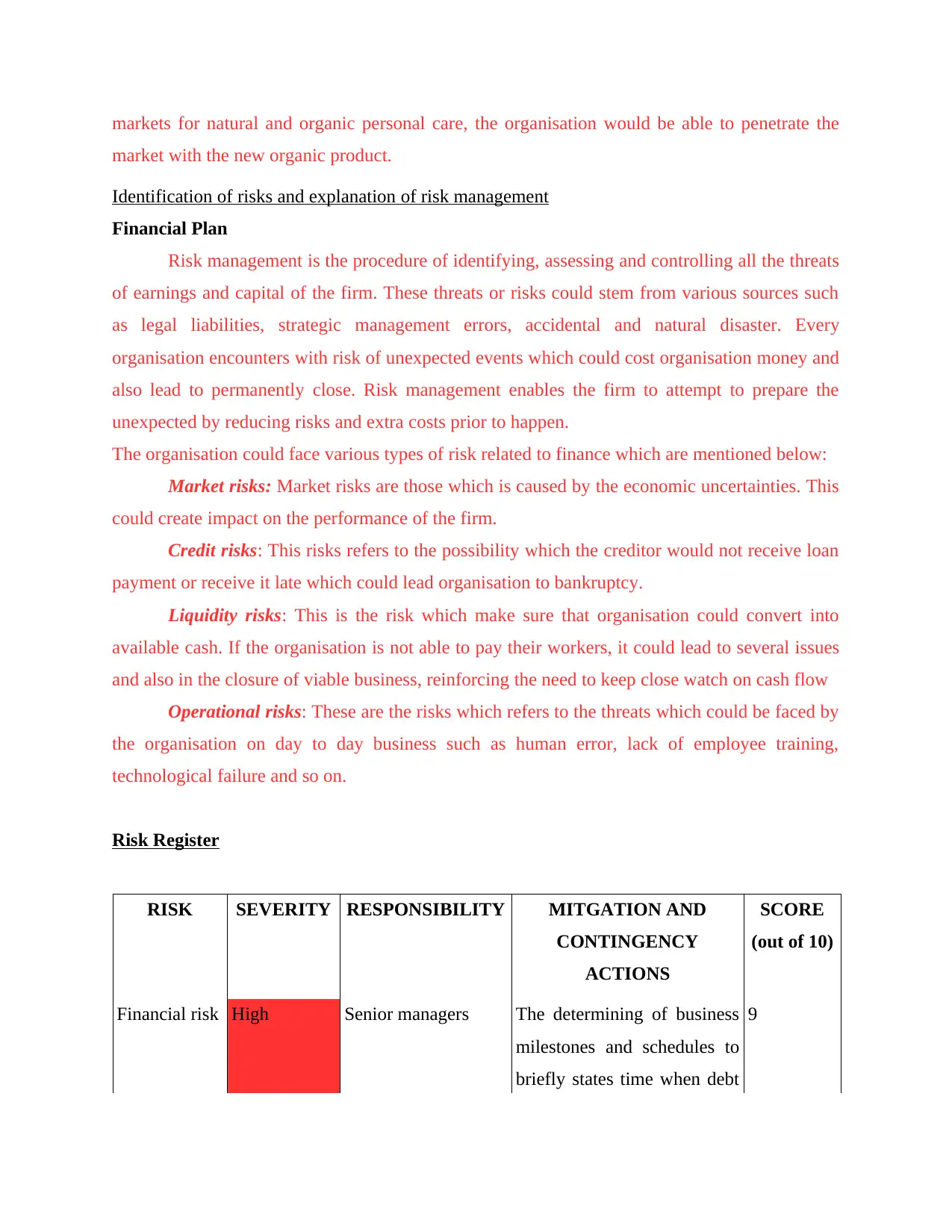
markets for natural and organic personal care, the organisation would be able to penetrate the
market with the new organic product.
Identification of risks and explanation of risk management
Financial Plan
Risk management is the procedure of identifying, assessing and controlling all the threats
of earnings and capital of the firm. These threats or risks could stem from various sources such
as legal liabilities, strategic management errors, accidental and natural disaster. Every
organisation encounters with risk of unexpected events which could cost organisation money and
also lead to permanently close. Risk management enables the firm to attempt to prepare the
unexpected by reducing risks and extra costs prior to happen.
The organisation could face various types of risk related to finance which are mentioned below:
Market risks: Market risks are those which is caused by the economic uncertainties. This
could create impact on the performance of the firm.
Credit risks: This risks refers to the possibility which the creditor would not receive loan
payment or receive it late which could lead organisation to bankruptcy.
Liquidity risks: This is the risk which make sure that organisation could convert into
available cash. If the organisation is not able to pay their workers, it could lead to several issues
and also in the closure of viable business, reinforcing the need to keep close watch on cash flow
Operational risks: These are the risks which refers to the threats which could be faced by
the organisation on day to day business such as human error, lack of employee training,
technological failure and so on.
Risk Register
RISK SEVERITY RESPONSIBILITY MITGATION AND
CONTINGENCY
ACTIONS
SCORE
(out of 10)
Financial risk High Senior managers The determining of business
milestones and schedules to
briefly states time when debt
9
market with the new organic product.
Identification of risks and explanation of risk management
Financial Plan
Risk management is the procedure of identifying, assessing and controlling all the threats
of earnings and capital of the firm. These threats or risks could stem from various sources such
as legal liabilities, strategic management errors, accidental and natural disaster. Every
organisation encounters with risk of unexpected events which could cost organisation money and
also lead to permanently close. Risk management enables the firm to attempt to prepare the
unexpected by reducing risks and extra costs prior to happen.
The organisation could face various types of risk related to finance which are mentioned below:
Market risks: Market risks are those which is caused by the economic uncertainties. This
could create impact on the performance of the firm.
Credit risks: This risks refers to the possibility which the creditor would not receive loan
payment or receive it late which could lead organisation to bankruptcy.
Liquidity risks: This is the risk which make sure that organisation could convert into
available cash. If the organisation is not able to pay their workers, it could lead to several issues
and also in the closure of viable business, reinforcing the need to keep close watch on cash flow
Operational risks: These are the risks which refers to the threats which could be faced by
the organisation on day to day business such as human error, lack of employee training,
technological failure and so on.
Risk Register
RISK SEVERITY RESPONSIBILITY MITGATION AND
CONTINGENCY
ACTIONS
SCORE
(out of 10)
Financial risk High Senior managers The determining of business
milestones and schedules to
briefly states time when debt
9
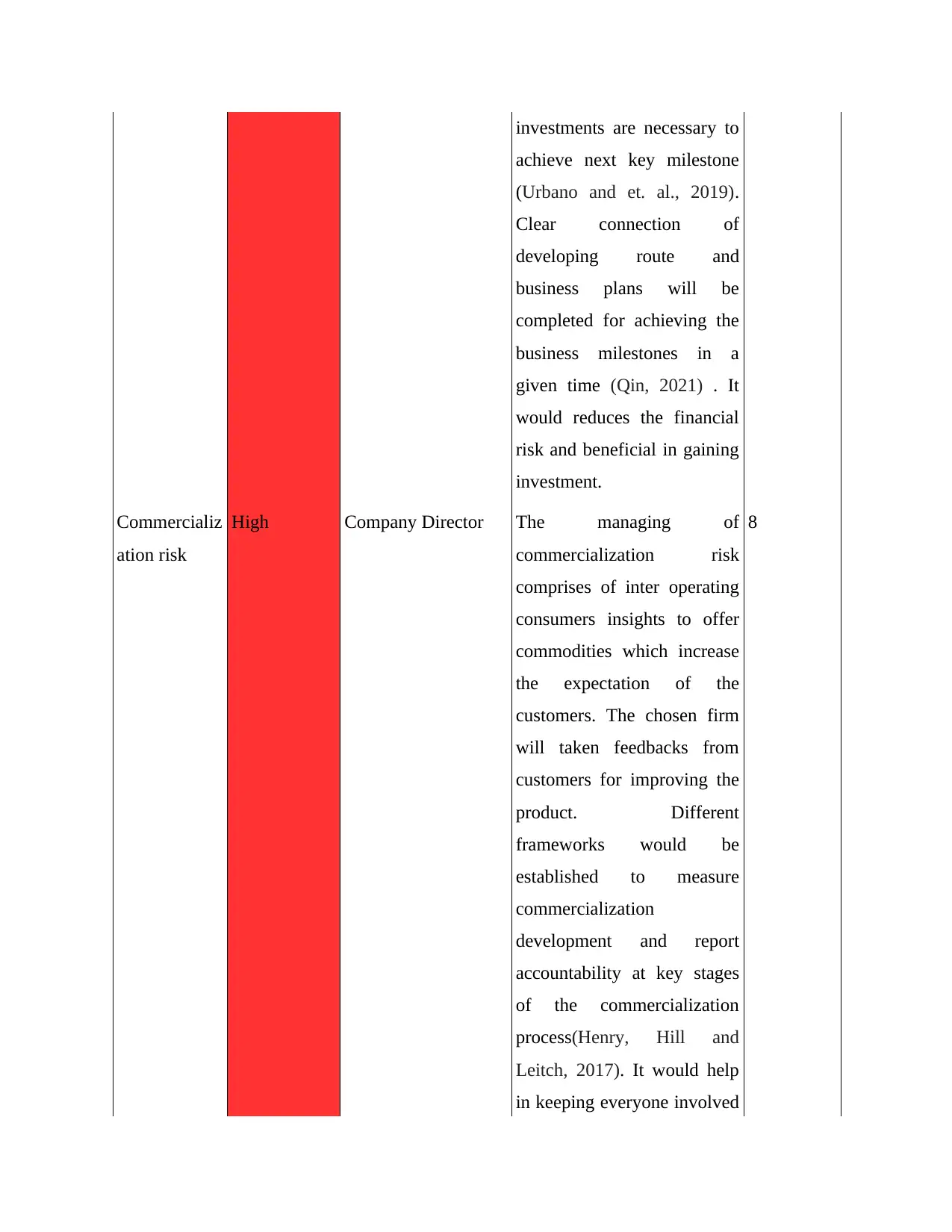
investments are necessary to
achieve next key milestone
(Urbano and et. al., 2019).
Clear connection of
developing route and
business plans will be
completed for achieving the
business milestones in a
given time (Qin, 2021) . It
would reduces the financial
risk and beneficial in gaining
investment.
Commercializ
ation risk
High Company Director The managing of
commercialization risk
comprises of inter operating
consumers insights to offer
commodities which increase
the expectation of the
customers. The chosen firm
will taken feedbacks from
customers for improving the
product. Different
frameworks would be
established to measure
commercialization
development and report
accountability at key stages
of the commercialization
process(Henry, Hill and
Leitch, 2017). It would help
in keeping everyone involved
8
achieve next key milestone
(Urbano and et. al., 2019).
Clear connection of
developing route and
business plans will be
completed for achieving the
business milestones in a
given time (Qin, 2021) . It
would reduces the financial
risk and beneficial in gaining
investment.
Commercializ
ation risk
High Company Director The managing of
commercialization risk
comprises of inter operating
consumers insights to offer
commodities which increase
the expectation of the
customers. The chosen firm
will taken feedbacks from
customers for improving the
product. Different
frameworks would be
established to measure
commercialization
development and report
accountability at key stages
of the commercialization
process(Henry, Hill and
Leitch, 2017). It would help
in keeping everyone involved
8
Paraphrase This Document
Need a fresh take? Get an instant paraphrase of this document with our AI Paraphraser
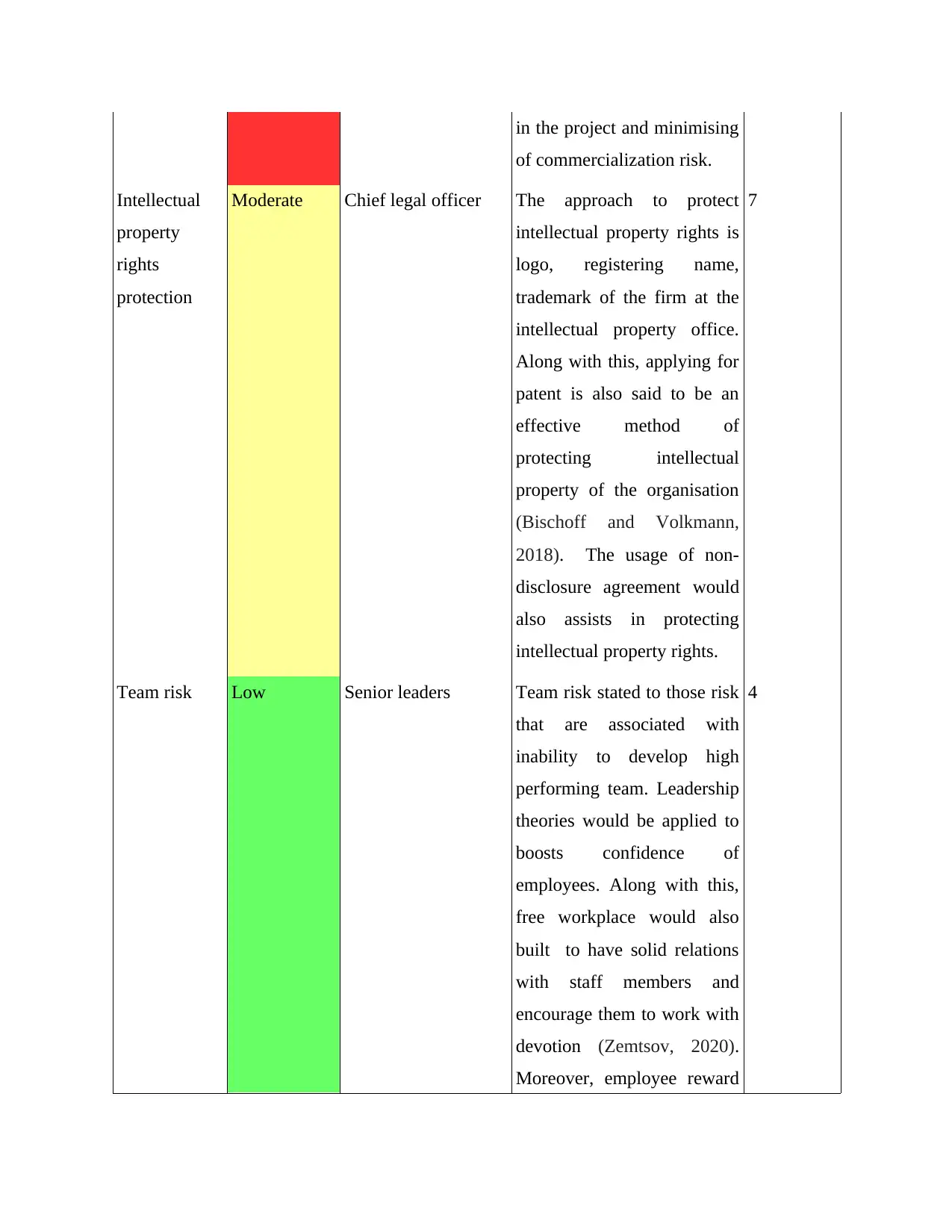
in the project and minimising
of commercialization risk.
Intellectual
property
rights
protection
Moderate Chief legal officer The approach to protect
intellectual property rights is
logo, registering name,
trademark of the firm at the
intellectual property office.
Along with this, applying for
patent is also said to be an
effective method of
protecting intellectual
property of the organisation
(Bischoff and Volkmann,
2018). The usage of non-
disclosure agreement would
also assists in protecting
intellectual property rights.
7
Team risk Low Senior leaders Team risk stated to those risk
that are associated with
inability to develop high
performing team. Leadership
theories would be applied to
boosts confidence of
employees. Along with this,
free workplace would also
built to have solid relations
with staff members and
encourage them to work with
devotion (Zemtsov, 2020).
Moreover, employee reward
4
of commercialization risk.
Intellectual
property
rights
protection
Moderate Chief legal officer The approach to protect
intellectual property rights is
logo, registering name,
trademark of the firm at the
intellectual property office.
Along with this, applying for
patent is also said to be an
effective method of
protecting intellectual
property of the organisation
(Bischoff and Volkmann,
2018). The usage of non-
disclosure agreement would
also assists in protecting
intellectual property rights.
7
Team risk Low Senior leaders Team risk stated to those risk
that are associated with
inability to develop high
performing team. Leadership
theories would be applied to
boosts confidence of
employees. Along with this,
free workplace would also
built to have solid relations
with staff members and
encourage them to work with
devotion (Zemtsov, 2020).
Moreover, employee reward
4
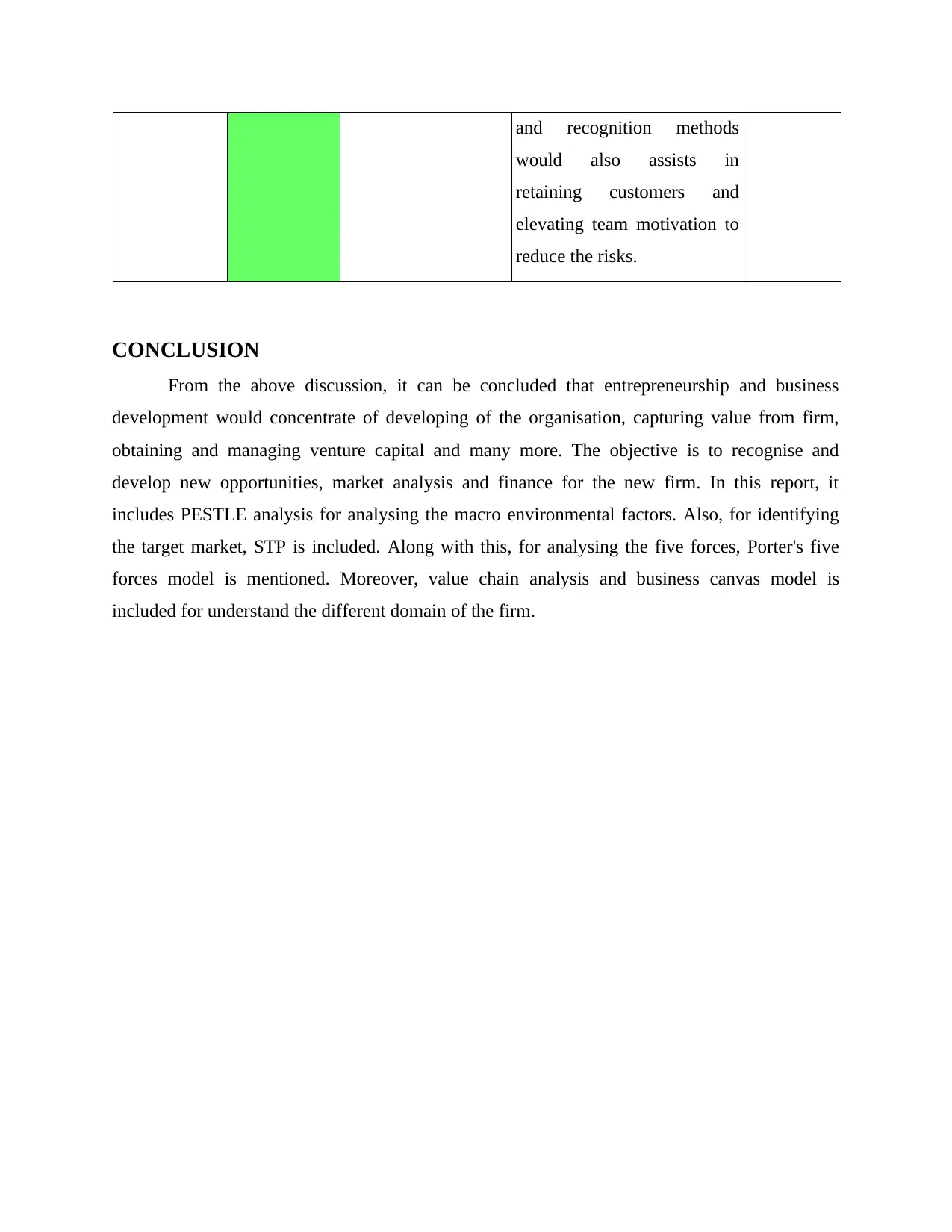
and recognition methods
would also assists in
retaining customers and
elevating team motivation to
reduce the risks.
CONCLUSION
From the above discussion, it can be concluded that entrepreneurship and business
development would concentrate of developing of the organisation, capturing value from firm,
obtaining and managing venture capital and many more. The objective is to recognise and
develop new opportunities, market analysis and finance for the new firm. In this report, it
includes PESTLE analysis for analysing the macro environmental factors. Also, for identifying
the target market, STP is included. Along with this, for analysing the five forces, Porter's five
forces model is mentioned. Moreover, value chain analysis and business canvas model is
included for understand the different domain of the firm.
would also assists in
retaining customers and
elevating team motivation to
reduce the risks.
CONCLUSION
From the above discussion, it can be concluded that entrepreneurship and business
development would concentrate of developing of the organisation, capturing value from firm,
obtaining and managing venture capital and many more. The objective is to recognise and
develop new opportunities, market analysis and finance for the new firm. In this report, it
includes PESTLE analysis for analysing the macro environmental factors. Also, for identifying
the target market, STP is included. Along with this, for analysing the five forces, Porter's five
forces model is mentioned. Moreover, value chain analysis and business canvas model is
included for understand the different domain of the firm.
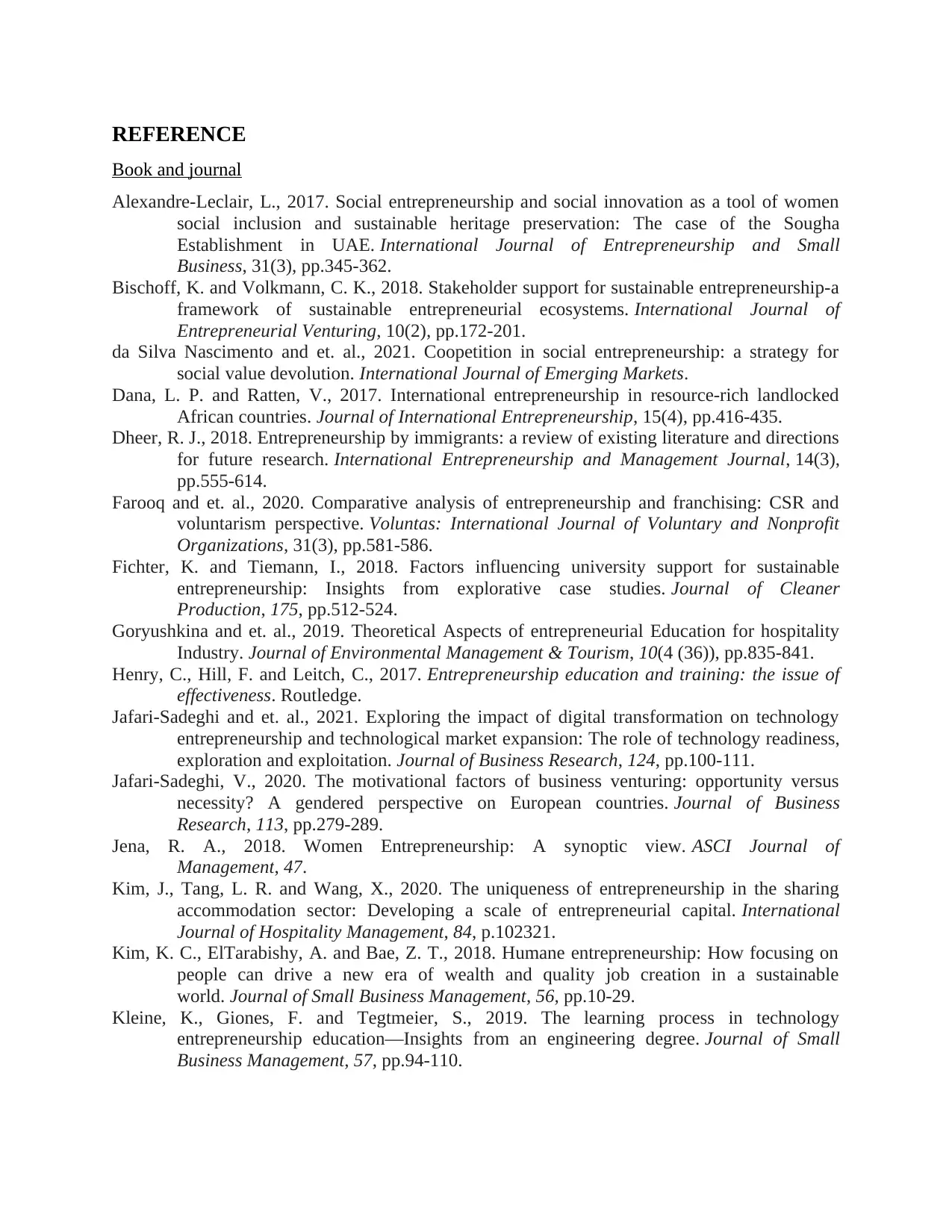
REFERENCE
Book and journal
Alexandre-Leclair, L., 2017. Social entrepreneurship and social innovation as a tool of women
social inclusion and sustainable heritage preservation: The case of the Sougha
Establishment in UAE. International Journal of Entrepreneurship and Small
Business, 31(3), pp.345-362.
Bischoff, K. and Volkmann, C. K., 2018. Stakeholder support for sustainable entrepreneurship-a
framework of sustainable entrepreneurial ecosystems. International Journal of
Entrepreneurial Venturing, 10(2), pp.172-201.
da Silva Nascimento and et. al., 2021. Coopetition in social entrepreneurship: a strategy for
social value devolution. International Journal of Emerging Markets.
Dana, L. P. and Ratten, V., 2017. International entrepreneurship in resource-rich landlocked
African countries. Journal of International Entrepreneurship, 15(4), pp.416-435.
Dheer, R. J., 2018. Entrepreneurship by immigrants: a review of existing literature and directions
for future research. International Entrepreneurship and Management Journal, 14(3),
pp.555-614.
Farooq and et. al., 2020. Comparative analysis of entrepreneurship and franchising: CSR and
voluntarism perspective. Voluntas: International Journal of Voluntary and Nonprofit
Organizations, 31(3), pp.581-586.
Fichter, K. and Tiemann, I., 2018. Factors influencing university support for sustainable
entrepreneurship: Insights from explorative case studies. Journal of Cleaner
Production, 175, pp.512-524.
Goryushkina and et. al., 2019. Theoretical Aspects of entrepreneurial Education for hospitality
Industry. Journal of Environmental Management & Tourism, 10(4 (36)), pp.835-841.
Henry, C., Hill, F. and Leitch, C., 2017. Entrepreneurship education and training: the issue of
effectiveness. Routledge.
Jafari-Sadeghi and et. al., 2021. Exploring the impact of digital transformation on technology
entrepreneurship and technological market expansion: The role of technology readiness,
exploration and exploitation. Journal of Business Research, 124, pp.100-111.
Jafari-Sadeghi, V., 2020. The motivational factors of business venturing: opportunity versus
necessity? A gendered perspective on European countries. Journal of Business
Research, 113, pp.279-289.
Jena, R. A., 2018. Women Entrepreneurship: A synoptic view. ASCI Journal of
Management, 47.
Kim, J., Tang, L. R. and Wang, X., 2020. The uniqueness of entrepreneurship in the sharing
accommodation sector: Developing a scale of entrepreneurial capital. International
Journal of Hospitality Management, 84, p.102321.
Kim, K. C., ElTarabishy, A. and Bae, Z. T., 2018. Humane entrepreneurship: How focusing on
people can drive a new era of wealth and quality job creation in a sustainable
world. Journal of Small Business Management, 56, pp.10-29.
Kleine, K., Giones, F. and Tegtmeier, S., 2019. The learning process in technology
entrepreneurship education—Insights from an engineering degree. Journal of Small
Business Management, 57, pp.94-110.
Book and journal
Alexandre-Leclair, L., 2017. Social entrepreneurship and social innovation as a tool of women
social inclusion and sustainable heritage preservation: The case of the Sougha
Establishment in UAE. International Journal of Entrepreneurship and Small
Business, 31(3), pp.345-362.
Bischoff, K. and Volkmann, C. K., 2018. Stakeholder support for sustainable entrepreneurship-a
framework of sustainable entrepreneurial ecosystems. International Journal of
Entrepreneurial Venturing, 10(2), pp.172-201.
da Silva Nascimento and et. al., 2021. Coopetition in social entrepreneurship: a strategy for
social value devolution. International Journal of Emerging Markets.
Dana, L. P. and Ratten, V., 2017. International entrepreneurship in resource-rich landlocked
African countries. Journal of International Entrepreneurship, 15(4), pp.416-435.
Dheer, R. J., 2018. Entrepreneurship by immigrants: a review of existing literature and directions
for future research. International Entrepreneurship and Management Journal, 14(3),
pp.555-614.
Farooq and et. al., 2020. Comparative analysis of entrepreneurship and franchising: CSR and
voluntarism perspective. Voluntas: International Journal of Voluntary and Nonprofit
Organizations, 31(3), pp.581-586.
Fichter, K. and Tiemann, I., 2018. Factors influencing university support for sustainable
entrepreneurship: Insights from explorative case studies. Journal of Cleaner
Production, 175, pp.512-524.
Goryushkina and et. al., 2019. Theoretical Aspects of entrepreneurial Education for hospitality
Industry. Journal of Environmental Management & Tourism, 10(4 (36)), pp.835-841.
Henry, C., Hill, F. and Leitch, C., 2017. Entrepreneurship education and training: the issue of
effectiveness. Routledge.
Jafari-Sadeghi and et. al., 2021. Exploring the impact of digital transformation on technology
entrepreneurship and technological market expansion: The role of technology readiness,
exploration and exploitation. Journal of Business Research, 124, pp.100-111.
Jafari-Sadeghi, V., 2020. The motivational factors of business venturing: opportunity versus
necessity? A gendered perspective on European countries. Journal of Business
Research, 113, pp.279-289.
Jena, R. A., 2018. Women Entrepreneurship: A synoptic view. ASCI Journal of
Management, 47.
Kim, J., Tang, L. R. and Wang, X., 2020. The uniqueness of entrepreneurship in the sharing
accommodation sector: Developing a scale of entrepreneurial capital. International
Journal of Hospitality Management, 84, p.102321.
Kim, K. C., ElTarabishy, A. and Bae, Z. T., 2018. Humane entrepreneurship: How focusing on
people can drive a new era of wealth and quality job creation in a sustainable
world. Journal of Small Business Management, 56, pp.10-29.
Kleine, K., Giones, F. and Tegtmeier, S., 2019. The learning process in technology
entrepreneurship education—Insights from an engineering degree. Journal of Small
Business Management, 57, pp.94-110.
Secure Best Marks with AI Grader
Need help grading? Try our AI Grader for instant feedback on your assignments.
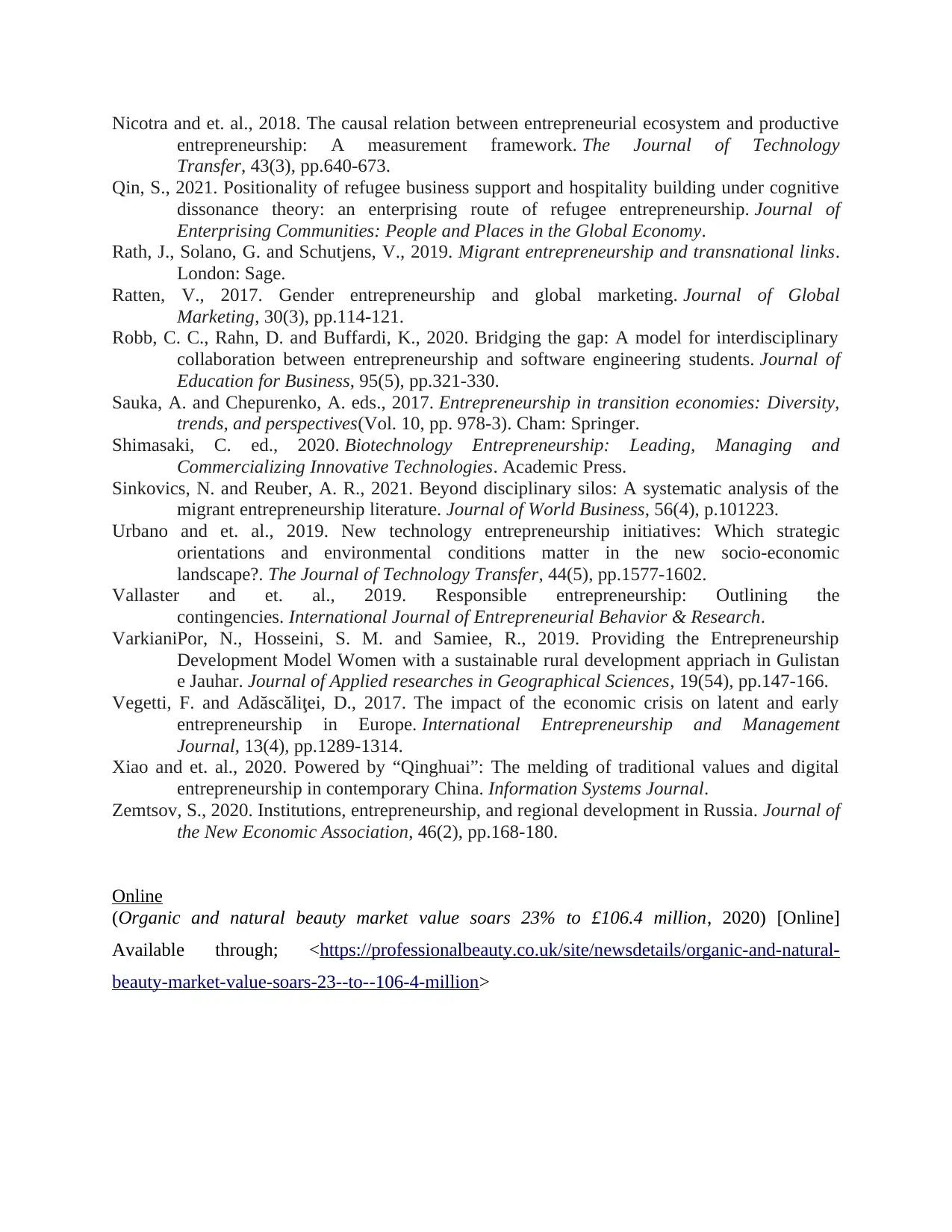
Nicotra and et. al., 2018. The causal relation between entrepreneurial ecosystem and productive
entrepreneurship: A measurement framework. The Journal of Technology
Transfer, 43(3), pp.640-673.
Qin, S., 2021. Positionality of refugee business support and hospitality building under cognitive
dissonance theory: an enterprising route of refugee entrepreneurship. Journal of
Enterprising Communities: People and Places in the Global Economy.
Rath, J., Solano, G. and Schutjens, V., 2019. Migrant entrepreneurship and transnational links.
London: Sage.
Ratten, V., 2017. Gender entrepreneurship and global marketing. Journal of Global
Marketing, 30(3), pp.114-121.
Robb, C. C., Rahn, D. and Buffardi, K., 2020. Bridging the gap: A model for interdisciplinary
collaboration between entrepreneurship and software engineering students. Journal of
Education for Business, 95(5), pp.321-330.
Sauka, A. and Chepurenko, A. eds., 2017. Entrepreneurship in transition economies: Diversity,
trends, and perspectives(Vol. 10, pp. 978-3). Cham: Springer.
Shimasaki, C. ed., 2020. Biotechnology Entrepreneurship: Leading, Managing and
Commercializing Innovative Technologies. Academic Press.
Sinkovics, N. and Reuber, A. R., 2021. Beyond disciplinary silos: A systematic analysis of the
migrant entrepreneurship literature. Journal of World Business, 56(4), p.101223.
Urbano and et. al., 2019. New technology entrepreneurship initiatives: Which strategic
orientations and environmental conditions matter in the new socio-economic
landscape?. The Journal of Technology Transfer, 44(5), pp.1577-1602.
Vallaster and et. al., 2019. Responsible entrepreneurship: Outlining the
contingencies. International Journal of Entrepreneurial Behavior & Research.
VarkianiPor, N., Hosseini, S. M. and Samiee, R., 2019. Providing the Entrepreneurship
Development Model Women with a sustainable rural development appriach in Gulistan
e Jauhar. Journal of Applied researches in Geographical Sciences, 19(54), pp.147-166.
Vegetti, F. and Adăscăliţei, D., 2017. The impact of the economic crisis on latent and early
entrepreneurship in Europe. International Entrepreneurship and Management
Journal, 13(4), pp.1289-1314.
Xiao and et. al., 2020. Powered by “Qinghuai”: The melding of traditional values and digital
entrepreneurship in contemporary China. Information Systems Journal.
Zemtsov, S., 2020. Institutions, entrepreneurship, and regional development in Russia. Journal of
the New Economic Association, 46(2), pp.168-180.
Online
(Organic and natural beauty market value soars 23% to £106.4 million, 2020) [Online]
Available through; <https://professionalbeauty.co.uk/site/newsdetails/organic-and-natural-
beauty-market-value-soars-23--to--106-4-million>
entrepreneurship: A measurement framework. The Journal of Technology
Transfer, 43(3), pp.640-673.
Qin, S., 2021. Positionality of refugee business support and hospitality building under cognitive
dissonance theory: an enterprising route of refugee entrepreneurship. Journal of
Enterprising Communities: People and Places in the Global Economy.
Rath, J., Solano, G. and Schutjens, V., 2019. Migrant entrepreneurship and transnational links.
London: Sage.
Ratten, V., 2017. Gender entrepreneurship and global marketing. Journal of Global
Marketing, 30(3), pp.114-121.
Robb, C. C., Rahn, D. and Buffardi, K., 2020. Bridging the gap: A model for interdisciplinary
collaboration between entrepreneurship and software engineering students. Journal of
Education for Business, 95(5), pp.321-330.
Sauka, A. and Chepurenko, A. eds., 2017. Entrepreneurship in transition economies: Diversity,
trends, and perspectives(Vol. 10, pp. 978-3). Cham: Springer.
Shimasaki, C. ed., 2020. Biotechnology Entrepreneurship: Leading, Managing and
Commercializing Innovative Technologies. Academic Press.
Sinkovics, N. and Reuber, A. R., 2021. Beyond disciplinary silos: A systematic analysis of the
migrant entrepreneurship literature. Journal of World Business, 56(4), p.101223.
Urbano and et. al., 2019. New technology entrepreneurship initiatives: Which strategic
orientations and environmental conditions matter in the new socio-economic
landscape?. The Journal of Technology Transfer, 44(5), pp.1577-1602.
Vallaster and et. al., 2019. Responsible entrepreneurship: Outlining the
contingencies. International Journal of Entrepreneurial Behavior & Research.
VarkianiPor, N., Hosseini, S. M. and Samiee, R., 2019. Providing the Entrepreneurship
Development Model Women with a sustainable rural development appriach in Gulistan
e Jauhar. Journal of Applied researches in Geographical Sciences, 19(54), pp.147-166.
Vegetti, F. and Adăscăliţei, D., 2017. The impact of the economic crisis on latent and early
entrepreneurship in Europe. International Entrepreneurship and Management
Journal, 13(4), pp.1289-1314.
Xiao and et. al., 2020. Powered by “Qinghuai”: The melding of traditional values and digital
entrepreneurship in contemporary China. Information Systems Journal.
Zemtsov, S., 2020. Institutions, entrepreneurship, and regional development in Russia. Journal of
the New Economic Association, 46(2), pp.168-180.
Online
(Organic and natural beauty market value soars 23% to £106.4 million, 2020) [Online]
Available through; <https://professionalbeauty.co.uk/site/newsdetails/organic-and-natural-
beauty-market-value-soars-23--to--106-4-million>
1 out of 17
Related Documents
Your All-in-One AI-Powered Toolkit for Academic Success.
+13062052269
info@desklib.com
Available 24*7 on WhatsApp / Email
![[object Object]](/_next/static/media/star-bottom.7253800d.svg)
Unlock your academic potential
© 2024 | Zucol Services PVT LTD | All rights reserved.





